Unit 9: Entrepreneurship and Small Business Management
VerifiedAdded on 2021/08/30
|23
|6122
|319
AI Summary
ASSIGNMENT 1 FRONT SHEET generally BTEC Level 4 HND Diploma in Business Unit number and title Unit 9: Entrepreneurship and Small Business Management Qualification Submission date 13/08/2021 Date received (1st submission) Date received (2nd submission) Re-identifies date Student name Ho Pham Linh Nhu Student ID TBS21010 Class GBS0904A Assessor name Truong Anh Tuyet Student declaration I certify that the assignment submission is entirely my own work and I fully understand the consequences of plagiarism
Contribute Materials
Your contribution can guide someone’s learning journey. Share your
documents today.
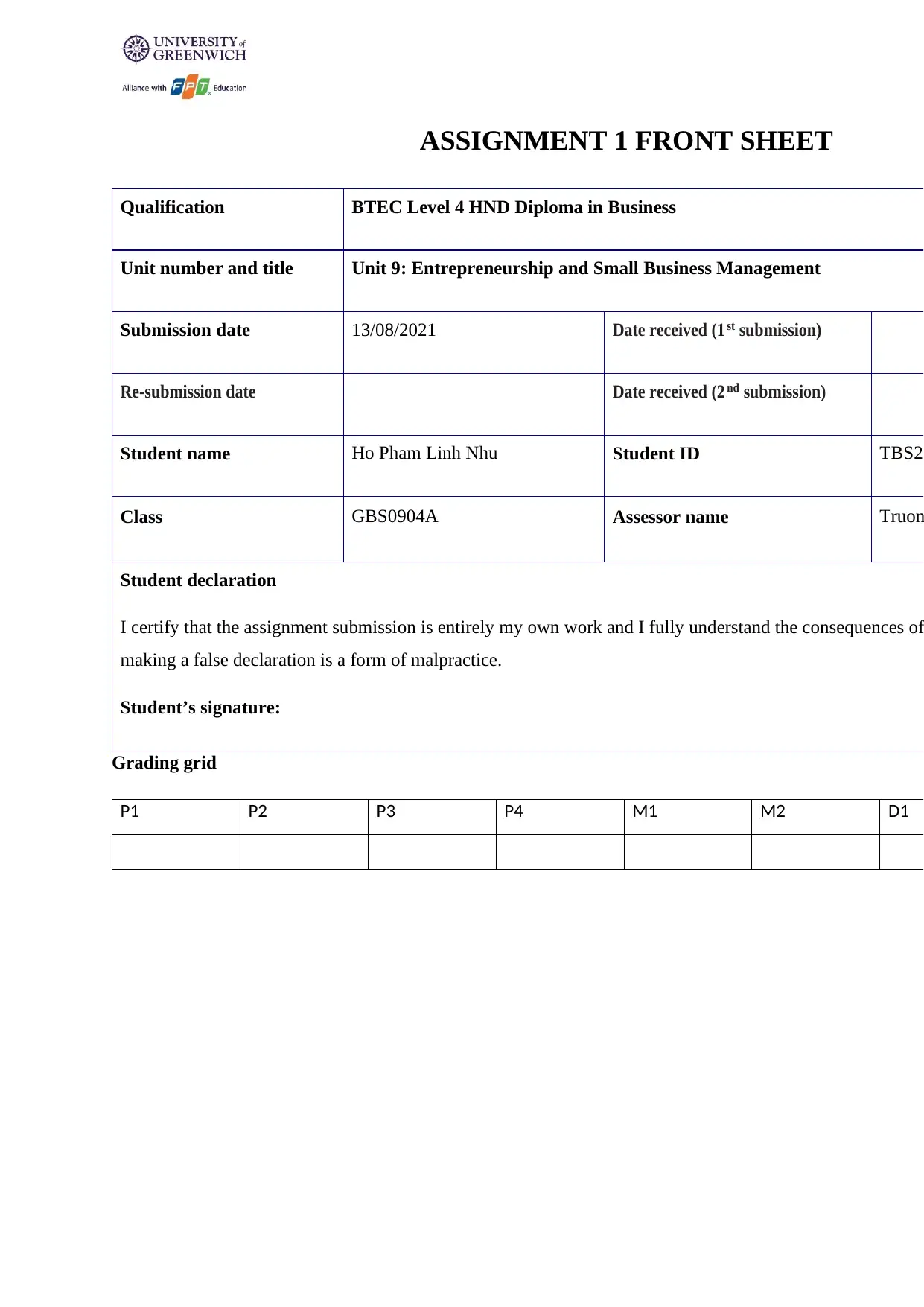
ASSIGNMENT 1 FRONT SHEET
Qualification BTEC Level 4 HND Diploma in Business
Unit number and title Unit 9: Entrepreneurship and Small Business Management
Submission date 13/08/2021 Date received (1 st submission)
Re-submission date Date received (2 nd submission)
Student name Ho Pham Linh Nhu Student ID TBS21
Class GBS0904A Assessor name Truon
Student declaration
I certify that the assignment submission is entirely my own work and I fully understand the consequences of
making a false declaration is a form of malpractice.
Student’s signature:
Grading grid
P1 P2 P3 P4 M1 M2 D1
Qualification BTEC Level 4 HND Diploma in Business
Unit number and title Unit 9: Entrepreneurship and Small Business Management
Submission date 13/08/2021 Date received (1 st submission)
Re-submission date Date received (2 nd submission)
Student name Ho Pham Linh Nhu Student ID TBS21
Class GBS0904A Assessor name Truon
Student declaration
I certify that the assignment submission is entirely my own work and I fully understand the consequences of
making a false declaration is a form of malpractice.
Student’s signature:
Grading grid
P1 P2 P3 P4 M1 M2 D1
Secure Best Marks with AI Grader
Need help grading? Try our AI Grader for instant feedback on your assignments.
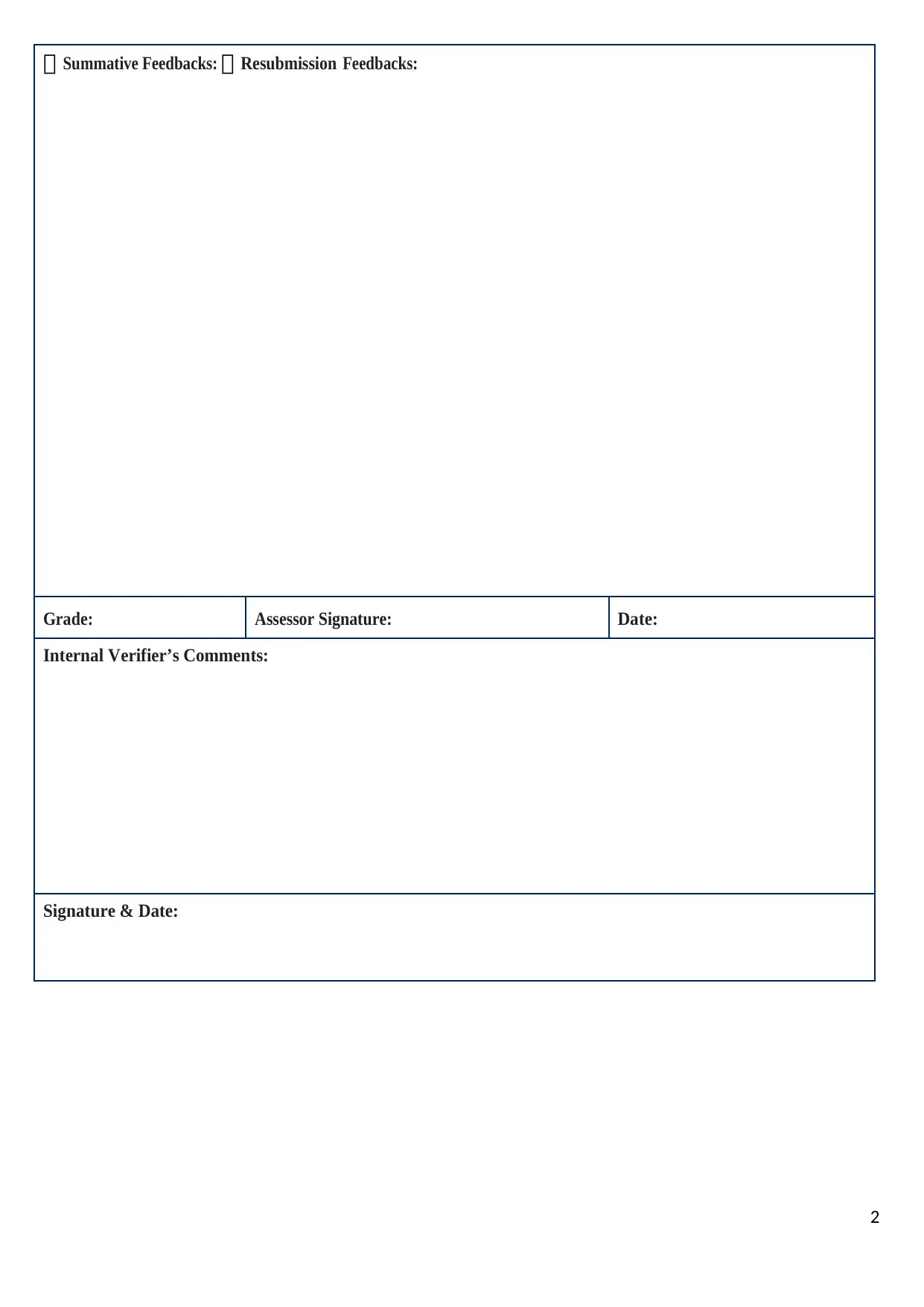
2
Summative Feedbacks: Resubmission Feedbacks:
Grade: Assessor Signature: Date:
Internal Verifier’s Comments:
Signature & Date:
Summative Feedbacks: Resubmission Feedbacks:
Grade: Assessor Signature: Date:
Internal Verifier’s Comments:
Signature & Date:
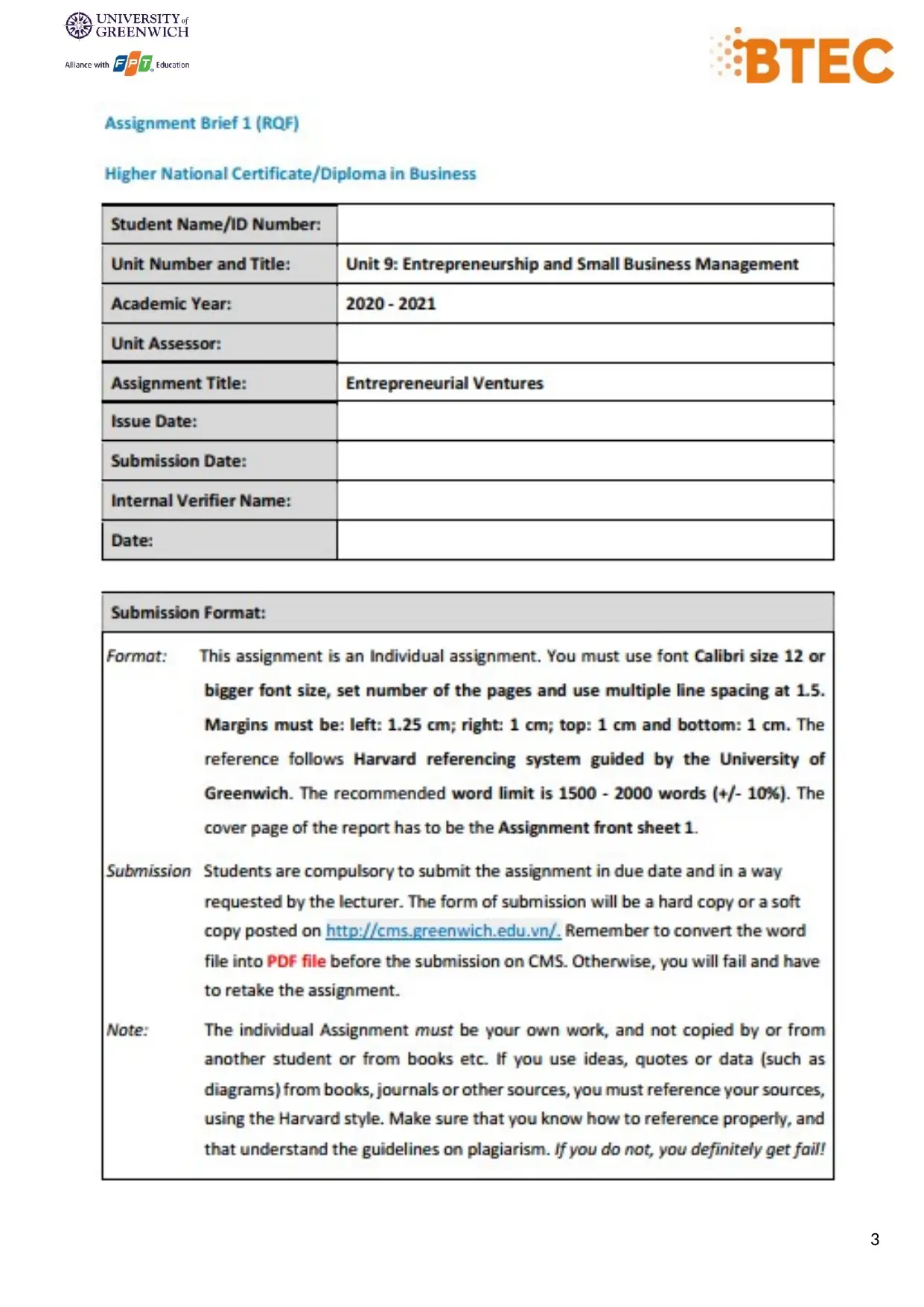
3
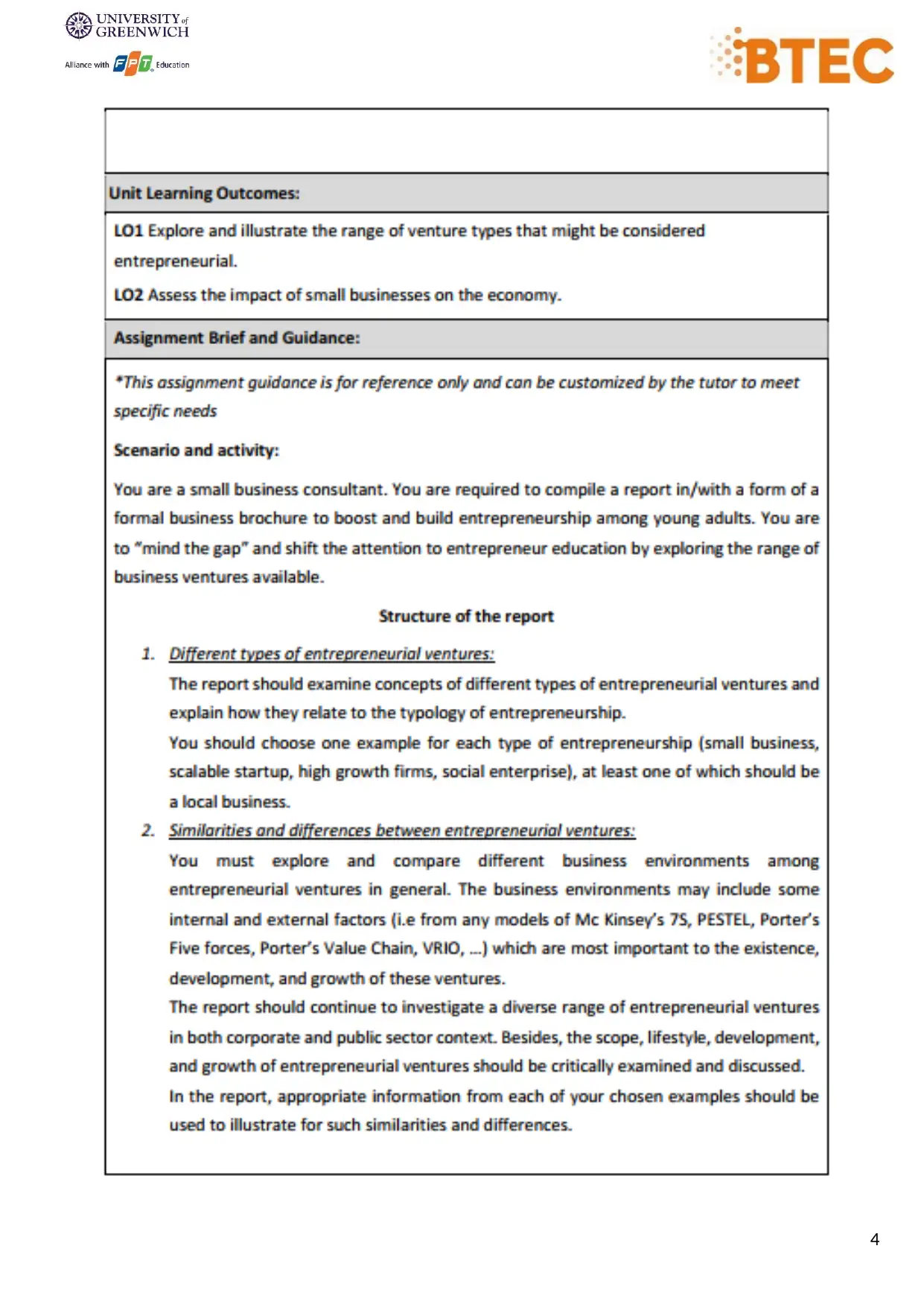
4
Secure Best Marks with AI Grader
Need help grading? Try our AI Grader for instant feedback on your assignments.
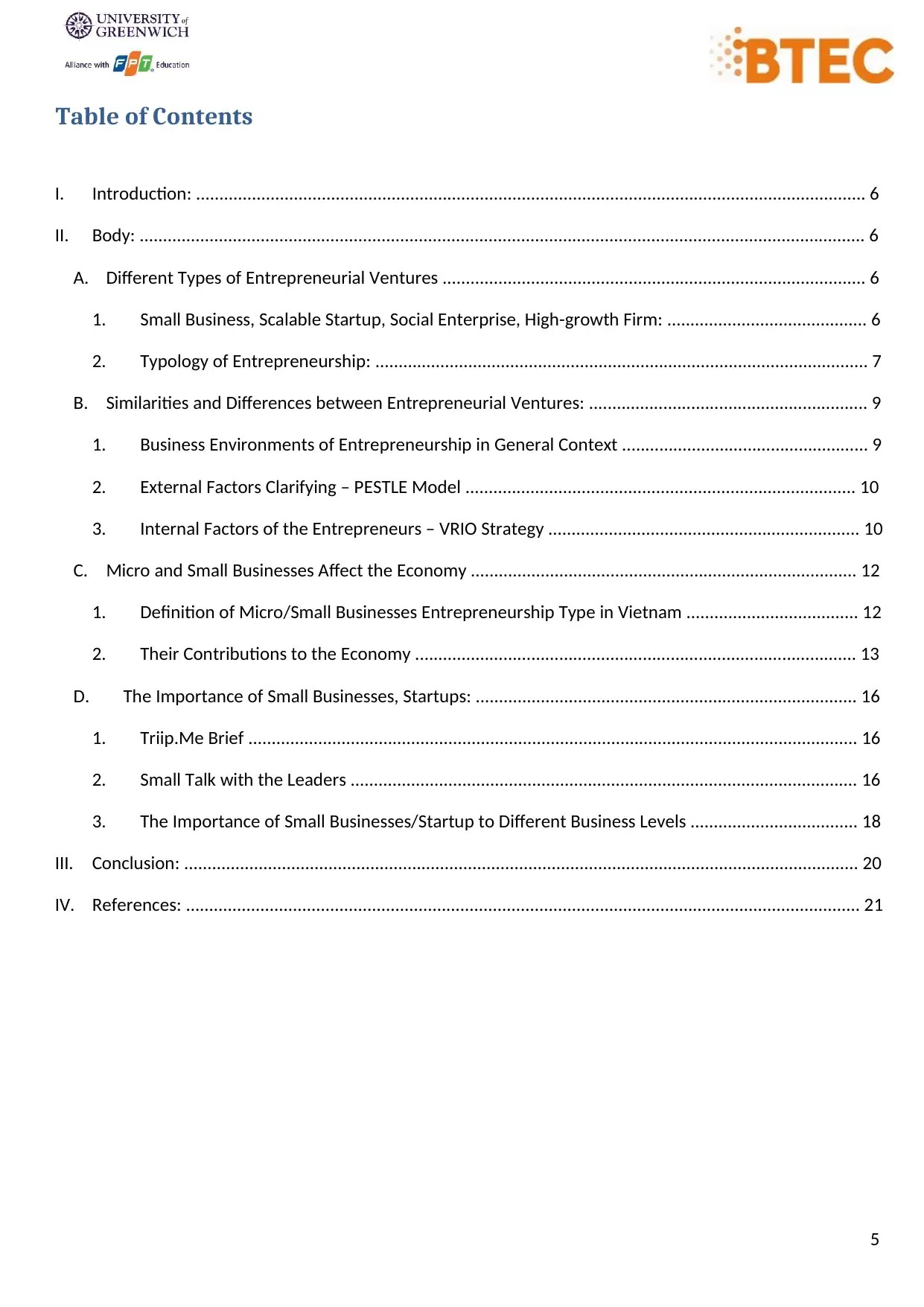
5
Table of Contents
I. Introduction: ................................................................................................................................................ 6
II. Body: ............................................................................................................................................................ 6
A. Different Types of Entrepreneurial Ventures ........................................................................................... 6
1. Small Business, Scalable Startup, Social Enterprise, High-growth Firm: ........................................... 6
2. Typology of Entrepreneurship: .......................................................................................................... 7
B. Similarities and Differences between Entrepreneurial Ventures: ............................................................ 9
1. Business Environments of Entrepreneurship in General Context ..................................................... 9
2. External Factors Clarifying – PESTLE Model .................................................................................... 10
3. Internal Factors of the Entrepreneurs – VRIO Strategy ................................................................... 10
C. Micro and Small Businesses Affect the Economy ................................................................................... 12
1. Definition of Micro/Small Businesses Entrepreneurship Type in Vietnam ..................................... 12
2. Their Contributions to the Economy ............................................................................................... 13
D. The Importance of Small Businesses, Startups: .................................................................................. 16
1. Triip.Me Brief ................................................................................................................................... 16
2. Small Talk with the Leaders ............................................................................................................. 16
3. The Importance of Small Businesses/Startup to Different Business Levels .................................... 18
III. Conclusion: ................................................................................................................................................. 20
IV. References: ................................................................................................................................................. 21
Table of Contents
I. Introduction: ................................................................................................................................................ 6
II. Body: ............................................................................................................................................................ 6
A. Different Types of Entrepreneurial Ventures ........................................................................................... 6
1. Small Business, Scalable Startup, Social Enterprise, High-growth Firm: ........................................... 6
2. Typology of Entrepreneurship: .......................................................................................................... 7
B. Similarities and Differences between Entrepreneurial Ventures: ............................................................ 9
1. Business Environments of Entrepreneurship in General Context ..................................................... 9
2. External Factors Clarifying – PESTLE Model .................................................................................... 10
3. Internal Factors of the Entrepreneurs – VRIO Strategy ................................................................... 10
C. Micro and Small Businesses Affect the Economy ................................................................................... 12
1. Definition of Micro/Small Businesses Entrepreneurship Type in Vietnam ..................................... 12
2. Their Contributions to the Economy ............................................................................................... 13
D. The Importance of Small Businesses, Startups: .................................................................................. 16
1. Triip.Me Brief ................................................................................................................................... 16
2. Small Talk with the Leaders ............................................................................................................. 16
3. The Importance of Small Businesses/Startup to Different Business Levels .................................... 18
III. Conclusion: ................................................................................................................................................. 20
IV. References: ................................................................................................................................................. 21

6
I. Introduction:
The below of this report follows the assumption, in which I’m a small business consultant. This report
will be in the form of a formal business manual as the assignment's need to promote and cultivate the
entrepreneurial spirit of Gen Z. The final aims are for persuading the community to "pay attention to the
missing gaps" then shifting it towards entrepreneurial education by exploring the scope of available business
risks.
II. Body:
A. Different Types of Entrepreneurial Ventures
Figure 1: Kansas City’s entrepreneurs and small businesses.
There are many approaches to call the variety of Entrepreneurship over the world. However, under
the scope of this material, we will divided into four distinct categories:
1. Small Business, Scalable Startup, Social Enterprise, High-growth Firm:
Small Businesses or sometimes “Survivalists" fundamentally aim to provide participating
entrepreneurs with basic life. The simple use only by word of mouth is allowed for this kind of business, and
the company may or may not be formally registered. These firms usually have no premises, few assets, no
commercial banking relationship, and operate in the form of a highly competitive, price-based, and largely
I. Introduction:
The below of this report follows the assumption, in which I’m a small business consultant. This report
will be in the form of a formal business manual as the assignment's need to promote and cultivate the
entrepreneurial spirit of Gen Z. The final aims are for persuading the community to "pay attention to the
missing gaps" then shifting it towards entrepreneurial education by exploring the scope of available business
risks.
II. Body:
A. Different Types of Entrepreneurial Ventures
Figure 1: Kansas City’s entrepreneurs and small businesses.
There are many approaches to call the variety of Entrepreneurship over the world. However, under
the scope of this material, we will divided into four distinct categories:
1. Small Business, Scalable Startup, Social Enterprise, High-growth Firm:
Small Businesses or sometimes “Survivalists" fundamentally aim to provide participating
entrepreneurs with basic life. The simple use only by word of mouth is allowed for this kind of business, and
the company may or may not be formally registered. These firms usually have no premises, few assets, no
commercial banking relationship, and operate in the form of a highly competitive, price-based, and largely
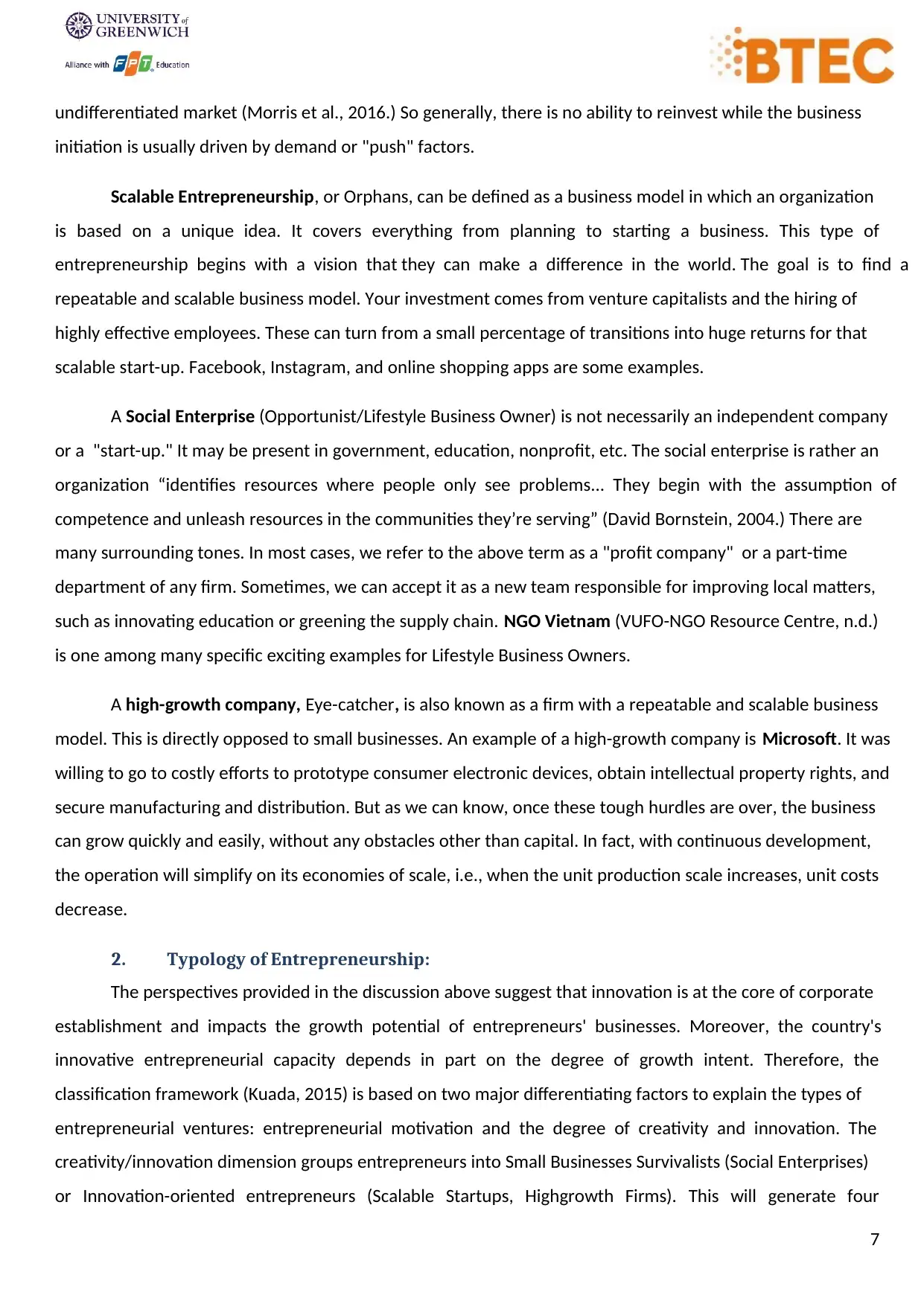
7
undifferentiated market (Morris et al., 2016.) So generally, there is no ability to reinvest while the business
initiation is usually driven by demand or "push" factors.
Scalable Entrepreneurship, or Orphans, can be defined as a business model in which an organization
is based on a unique idea. It covers everything from planning to starting a business. This type of
entrepreneurship begins with a vision that they can make a difference in the world. The goal is to find a
repeatable and scalable business model. Your investment comes from venture capitalists and the hiring of
highly effective employees. These can turn from a small percentage of transitions into huge returns for that
scalable start-up. Facebook, Instagram, and online shopping apps are some examples.
A Social Enterprise (Opportunist/Lifestyle Business Owner) is not necessarily an independent company
or a "start-up." It may be present in government, education, nonprofit, etc. The social enterprise is rather an
organization “identifies resources where people only see problems... They begin with the assumption of
competence and unleash resources in the communities they’re serving” (David Bornstein, 2004.) There are
many surrounding tones. In most cases, we refer to the above term as a "profit company" or a part-time
department of any firm. Sometimes, we can accept it as a new team responsible for improving local matters,
such as innovating education or greening the supply chain. NGO Vietnam (VUFO-NGO Resource Centre, n.d.)
is one among many specific exciting examples for Lifestyle Business Owners.
A high-growth company, Eye-catcher, is also known as a firm with a repeatable and scalable business
model. This is directly opposed to small businesses. An example of a high-growth company is Microsoft. It was
willing to go to costly efforts to prototype consumer electronic devices, obtain intellectual property rights, and
secure manufacturing and distribution. But as we can know, once these tough hurdles are over, the business
can grow quickly and easily, without any obstacles other than capital. In fact, with continuous development,
the operation will simplify on its economies of scale, i.e., when the unit production scale increases, unit costs
decrease.
2. Typology of Entrepreneurship:
The perspectives provided in the discussion above suggest that innovation is at the core of corporate
establishment and impacts the growth potential of entrepreneurs' businesses. Moreover, the country's
innovative entrepreneurial capacity depends in part on the degree of growth intent. Therefore, the
classification framework (Kuada, 2015) is based on two major differentiating factors to explain the types of
entrepreneurial ventures: entrepreneurial motivation and the degree of creativity and innovation. The
creativity/innovation dimension groups entrepreneurs into Small Businesses Survivalists (Social Enterprises)
or Innovation-oriented entrepreneurs (Scalable Startups, Highgrowth Firms). This will generate four
undifferentiated market (Morris et al., 2016.) So generally, there is no ability to reinvest while the business
initiation is usually driven by demand or "push" factors.
Scalable Entrepreneurship, or Orphans, can be defined as a business model in which an organization
is based on a unique idea. It covers everything from planning to starting a business. This type of
entrepreneurship begins with a vision that they can make a difference in the world. The goal is to find a
repeatable and scalable business model. Your investment comes from venture capitalists and the hiring of
highly effective employees. These can turn from a small percentage of transitions into huge returns for that
scalable start-up. Facebook, Instagram, and online shopping apps are some examples.
A Social Enterprise (Opportunist/Lifestyle Business Owner) is not necessarily an independent company
or a "start-up." It may be present in government, education, nonprofit, etc. The social enterprise is rather an
organization “identifies resources where people only see problems... They begin with the assumption of
competence and unleash resources in the communities they’re serving” (David Bornstein, 2004.) There are
many surrounding tones. In most cases, we refer to the above term as a "profit company" or a part-time
department of any firm. Sometimes, we can accept it as a new team responsible for improving local matters,
such as innovating education or greening the supply chain. NGO Vietnam (VUFO-NGO Resource Centre, n.d.)
is one among many specific exciting examples for Lifestyle Business Owners.
A high-growth company, Eye-catcher, is also known as a firm with a repeatable and scalable business
model. This is directly opposed to small businesses. An example of a high-growth company is Microsoft. It was
willing to go to costly efforts to prototype consumer electronic devices, obtain intellectual property rights, and
secure manufacturing and distribution. But as we can know, once these tough hurdles are over, the business
can grow quickly and easily, without any obstacles other than capital. In fact, with continuous development,
the operation will simplify on its economies of scale, i.e., when the unit production scale increases, unit costs
decrease.
2. Typology of Entrepreneurship:
The perspectives provided in the discussion above suggest that innovation is at the core of corporate
establishment and impacts the growth potential of entrepreneurs' businesses. Moreover, the country's
innovative entrepreneurial capacity depends in part on the degree of growth intent. Therefore, the
classification framework (Kuada, 2015) is based on two major differentiating factors to explain the types of
entrepreneurial ventures: entrepreneurial motivation and the degree of creativity and innovation. The
creativity/innovation dimension groups entrepreneurs into Small Businesses Survivalists (Social Enterprises)
or Innovation-oriented entrepreneurs (Scalable Startups, Highgrowth Firms). This will generate four
Paraphrase This Document
Need a fresh take? Get an instant paraphrase of this document with our AI Paraphraser
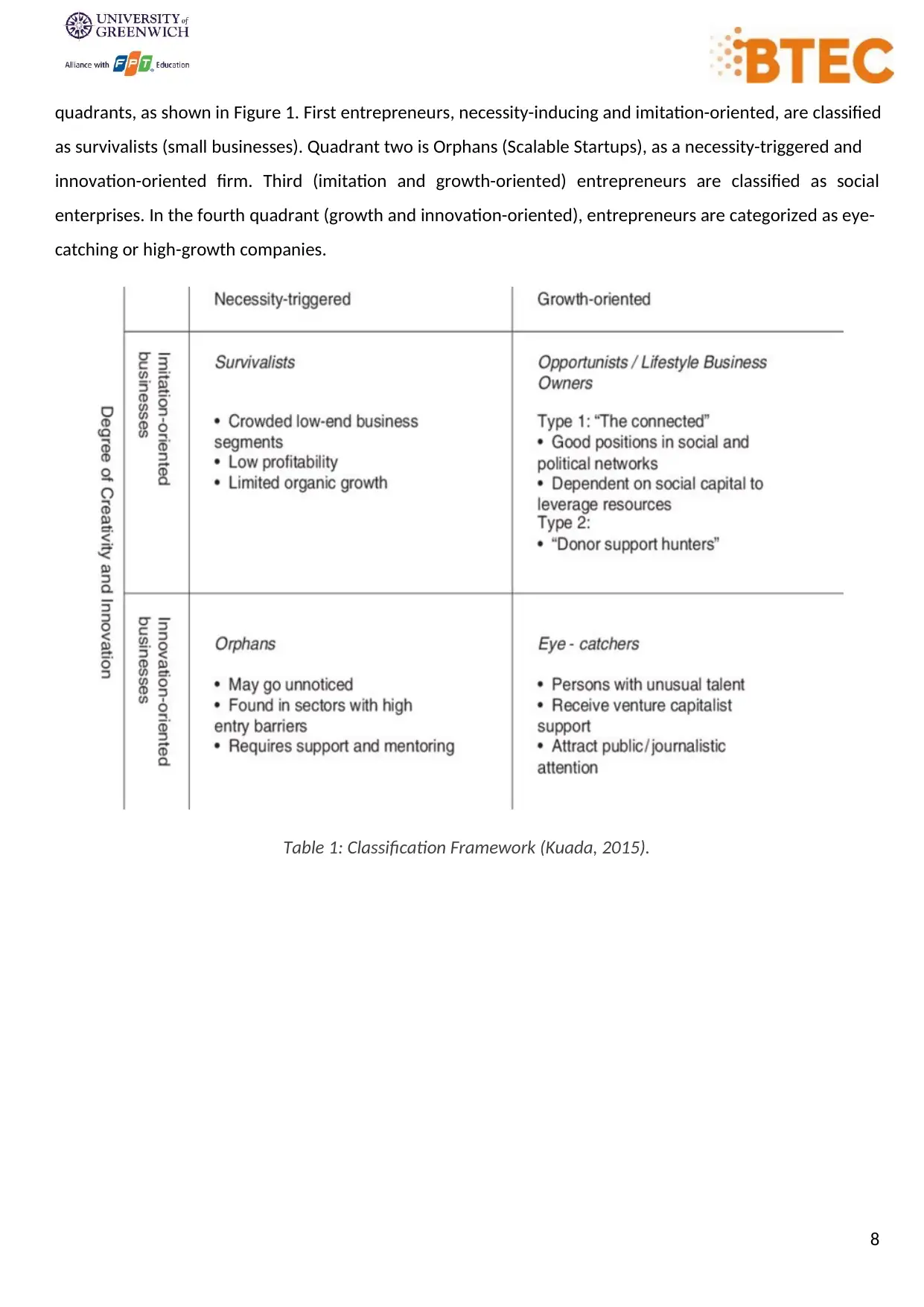
8
quadrants, as shown in Figure 1. First entrepreneurs, necessity-inducing and imitation-oriented, are classified
as survivalists (small businesses). Quadrant two is Orphans (Scalable Startups), as a necessity-triggered and
innovation-oriented firm. Third (imitation and growth-oriented) entrepreneurs are classified as social
enterprises. In the fourth quadrant (growth and innovation-oriented), entrepreneurs are categorized as eye-
catching or high-growth companies.
Table 1: Classification Framework (Kuada, 2015).
quadrants, as shown in Figure 1. First entrepreneurs, necessity-inducing and imitation-oriented, are classified
as survivalists (small businesses). Quadrant two is Orphans (Scalable Startups), as a necessity-triggered and
innovation-oriented firm. Third (imitation and growth-oriented) entrepreneurs are classified as social
enterprises. In the fourth quadrant (growth and innovation-oriented), entrepreneurs are categorized as eye-
catching or high-growth companies.
Table 1: Classification Framework (Kuada, 2015).

9
B. Similarities and Differences between Entrepreneurial Ventures:
To enter the entrepreneurial industry, participants, at first, must have a clear understanding of the
surrounding conditions and forces. According to Professional Academy (n.d.), we have the brief over many
different kinds of environments.
1. Business Environments of Entrepreneurship in General Context
Figure 3: The Essential Environments of Entrepreneur Ventures.
The microenvironment is all within reach of the company. These are the forces involved in the day-to-
day operation of the business, and the business has some control over these areas. Here is some distinctive
aspects to recognize those four kinds of entrepreneurs:
Small Businesses Scalable Startups Social Enterprises High-growth Firms
Small Small or Medium Small, Medium or Large Medium or Large
Reactive Tactical Strategic, can be
proactive (global case)
Strategic and proactive
No specific objective or
only one
Give what customers
need
Develops the framework
of operations
Innovative is essential
Seek to earn capital
Provide products or
services support society
Sustainable
development objective
Provide new core-built
products
B. Similarities and Differences between Entrepreneurial Ventures:
To enter the entrepreneurial industry, participants, at first, must have a clear understanding of the
surrounding conditions and forces. According to Professional Academy (n.d.), we have the brief over many
different kinds of environments.
1. Business Environments of Entrepreneurship in General Context
Figure 3: The Essential Environments of Entrepreneur Ventures.
The microenvironment is all within reach of the company. These are the forces involved in the day-to-
day operation of the business, and the business has some control over these areas. Here is some distinctive
aspects to recognize those four kinds of entrepreneurs:
Small Businesses Scalable Startups Social Enterprises High-growth Firms
Small Small or Medium Small, Medium or Large Medium or Large
Reactive Tactical Strategic, can be
proactive (global case)
Strategic and proactive
No specific objective or
only one
Give what customers
need
Develops the framework
of operations
Innovative is essential
Seek to earn capital
Provide products or
services support society
Sustainable
development objective
Provide new core-built
products
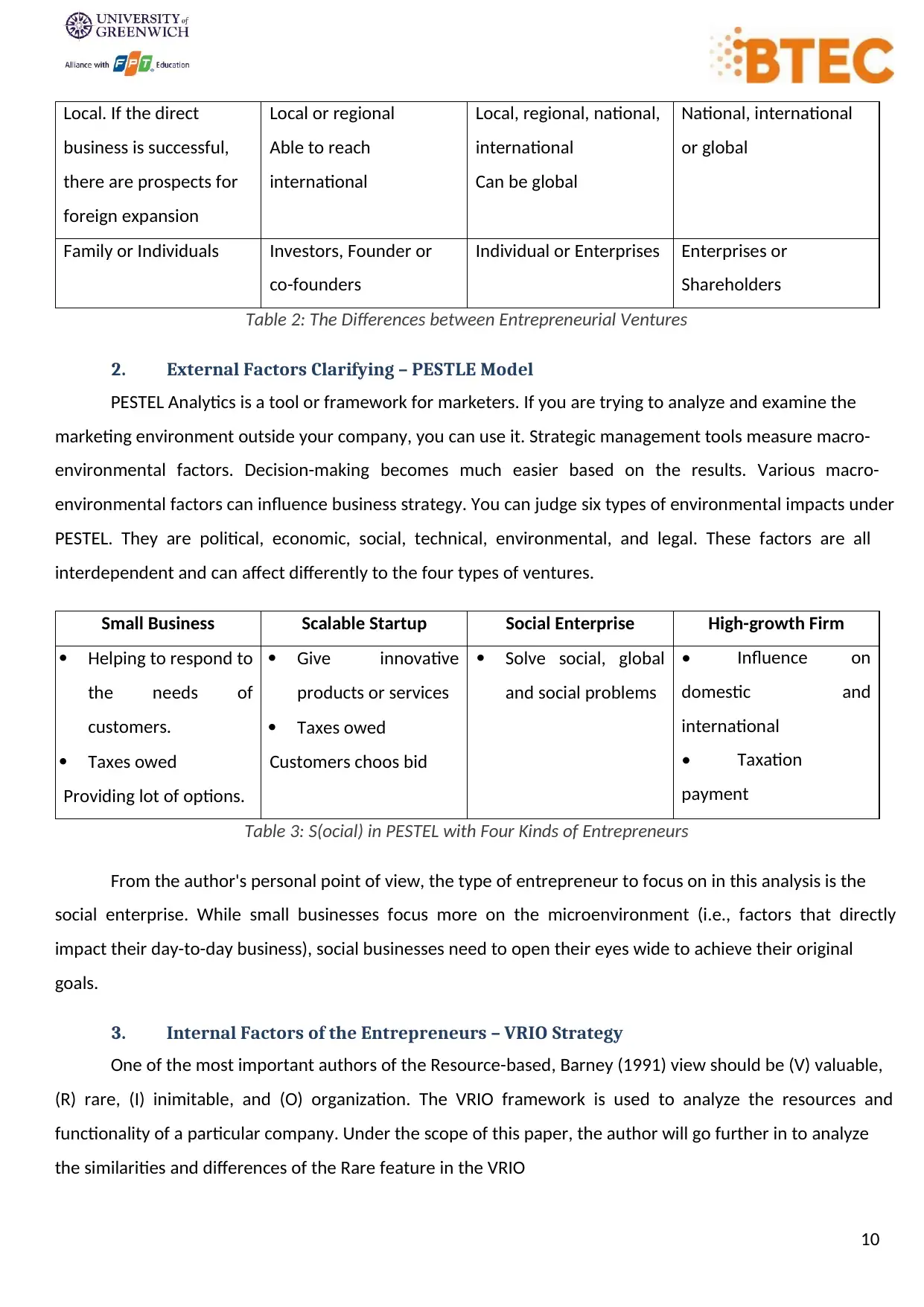
10
Local. If the direct
business is successful,
there are prospects for
foreign expansion
Local or regional
Able to reach
international
Local, regional, national,
international
Can be global
National, international
or global
Family or Individuals Investors, Founder or
co-founders
Individual or Enterprises Enterprises or
Shareholders
Table 2: The Differences between Entrepreneurial Ventures
2. External Factors Clarifying – PESTLE Model
PESTEL Analytics is a tool or framework for marketers. If you are trying to analyze and examine the
marketing environment outside your company, you can use it. Strategic management tools measure macro-
environmental factors. Decision-making becomes much easier based on the results. Various macro-
environmental factors can influence business strategy. You can judge six types of environmental impacts under
PESTEL. They are political, economic, social, technical, environmental, and legal. These factors are all
interdependent and can affect differently to the four types of ventures.
Small Business Scalable Startup Social Enterprise High-growth Firm
Helping to respond to
the needs of
customers.
Taxes owed
Providing lot of options.
Give innovative
products or services
Taxes owed
Customers choos bid
Solve social, global
and social problems
• Influence on
domestic and
international
• Taxation
payment
Table 3: S(ocial) in PESTEL with Four Kinds of Entrepreneurs
From the author's personal point of view, the type of entrepreneur to focus on in this analysis is the
social enterprise. While small businesses focus more on the microenvironment (i.e., factors that directly
impact their day-to-day business), social businesses need to open their eyes wide to achieve their original
goals.
3. Internal Factors of the Entrepreneurs – VRIO Strategy
One of the most important authors of the Resource-based, Barney (1991) view should be (V) valuable,
(R) rare, (I) inimitable, and (O) organization. The VRIO framework is used to analyze the resources and
functionality of a particular company. Under the scope of this paper, the author will go further in to analyze
the similarities and differences of the Rare feature in the VRIO
Local. If the direct
business is successful,
there are prospects for
foreign expansion
Local or regional
Able to reach
international
Local, regional, national,
international
Can be global
National, international
or global
Family or Individuals Investors, Founder or
co-founders
Individual or Enterprises Enterprises or
Shareholders
Table 2: The Differences between Entrepreneurial Ventures
2. External Factors Clarifying – PESTLE Model
PESTEL Analytics is a tool or framework for marketers. If you are trying to analyze and examine the
marketing environment outside your company, you can use it. Strategic management tools measure macro-
environmental factors. Decision-making becomes much easier based on the results. Various macro-
environmental factors can influence business strategy. You can judge six types of environmental impacts under
PESTEL. They are political, economic, social, technical, environmental, and legal. These factors are all
interdependent and can affect differently to the four types of ventures.
Small Business Scalable Startup Social Enterprise High-growth Firm
Helping to respond to
the needs of
customers.
Taxes owed
Providing lot of options.
Give innovative
products or services
Taxes owed
Customers choos bid
Solve social, global
and social problems
• Influence on
domestic and
international
• Taxation
payment
Table 3: S(ocial) in PESTEL with Four Kinds of Entrepreneurs
From the author's personal point of view, the type of entrepreneur to focus on in this analysis is the
social enterprise. While small businesses focus more on the microenvironment (i.e., factors that directly
impact their day-to-day business), social businesses need to open their eyes wide to achieve their original
goals.
3. Internal Factors of the Entrepreneurs – VRIO Strategy
One of the most important authors of the Resource-based, Barney (1991) view should be (V) valuable,
(R) rare, (I) inimitable, and (O) organization. The VRIO framework is used to analyze the resources and
functionality of a particular company. Under the scope of this paper, the author will go further in to analyze
the similarities and differences of the Rare feature in the VRIO
Secure Best Marks with AI Grader
Need help grading? Try our AI Grader for instant feedback on your assignments.
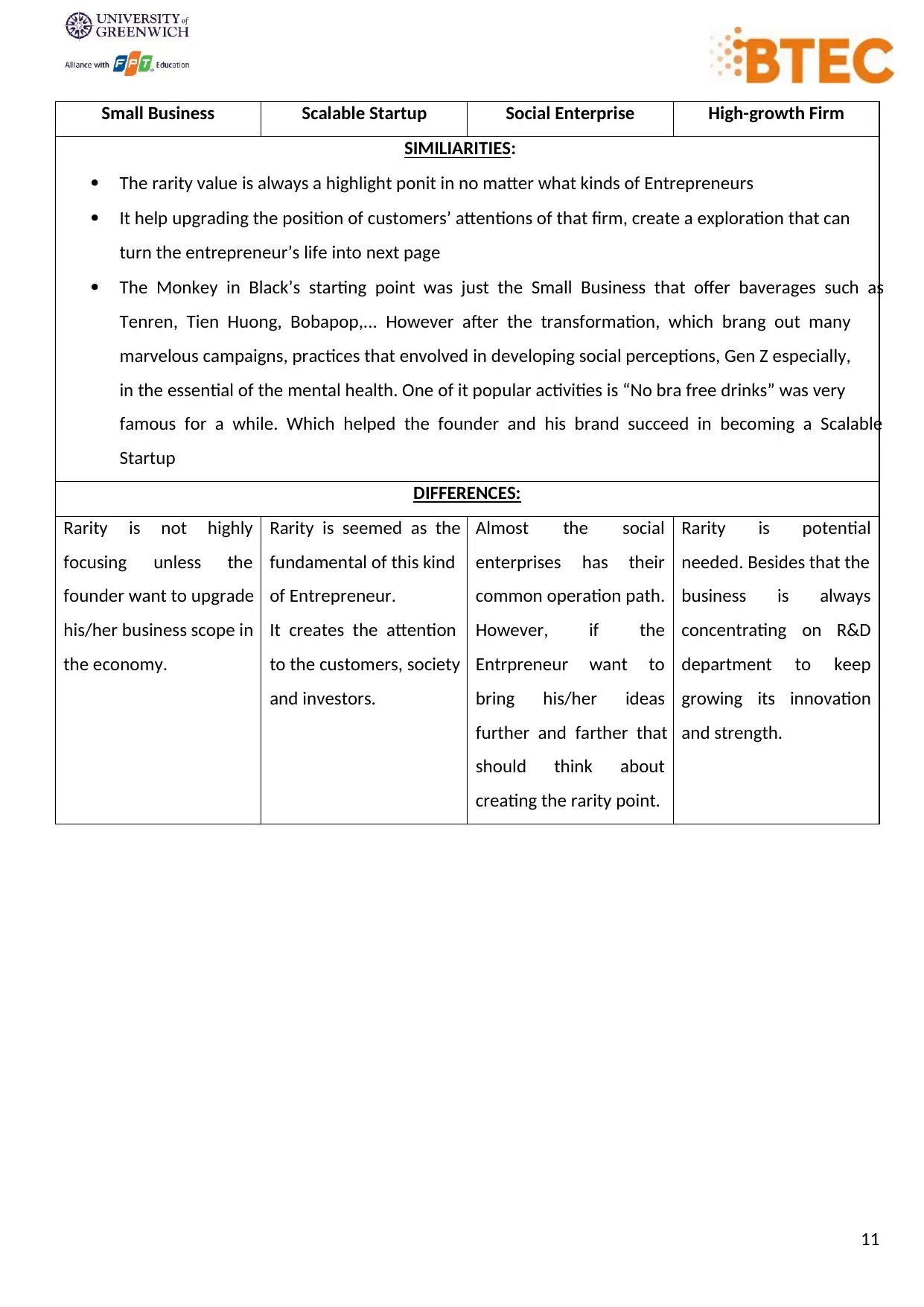
11
Small Business Scalable Startup Social Enterprise High-growth Firm
SIMILIARITIES:
The rarity value is always a highlight ponit in no matter what kinds of Entrepreneurs
It help upgrading the position of customers’ attentions of that firm, create a exploration that can
turn the entrepreneur’s life into next page
The Monkey in Black’s starting point was just the Small Business that offer baverages such as
Tenren, Tien Huong, Bobapop,... However after the transformation, which brang out many
marvelous campaigns, practices that envolved in developing social perceptions, Gen Z especially,
in the essential of the mental health. One of it popular activities is “No bra free drinks” was very
famous for a while. Which helped the founder and his brand succeed in becoming a Scalable
Startup
DIFFERENCES:
Rarity is not highly
focusing unless the
founder want to upgrade
his/her business scope in
the economy.
Rarity is seemed as the
fundamental of this kind
of Entrepreneur.
It creates the attention
to the customers, society
and investors.
Almost the social
enterprises has their
common operation path.
However, if the
Entrpreneur want to
bring his/her ideas
further and farther that
should think about
creating the rarity point.
Rarity is potential
needed. Besides that the
business is always
concentrating on R&D
department to keep
growing its innovation
and strength.
Small Business Scalable Startup Social Enterprise High-growth Firm
SIMILIARITIES:
The rarity value is always a highlight ponit in no matter what kinds of Entrepreneurs
It help upgrading the position of customers’ attentions of that firm, create a exploration that can
turn the entrepreneur’s life into next page
The Monkey in Black’s starting point was just the Small Business that offer baverages such as
Tenren, Tien Huong, Bobapop,... However after the transformation, which brang out many
marvelous campaigns, practices that envolved in developing social perceptions, Gen Z especially,
in the essential of the mental health. One of it popular activities is “No bra free drinks” was very
famous for a while. Which helped the founder and his brand succeed in becoming a Scalable
Startup
DIFFERENCES:
Rarity is not highly
focusing unless the
founder want to upgrade
his/her business scope in
the economy.
Rarity is seemed as the
fundamental of this kind
of Entrepreneur.
It creates the attention
to the customers, society
and investors.
Almost the social
enterprises has their
common operation path.
However, if the
Entrpreneur want to
bring his/her ideas
further and farther that
should think about
creating the rarity point.
Rarity is potential
needed. Besides that the
business is always
concentrating on R&D
department to keep
growing its innovation
and strength.
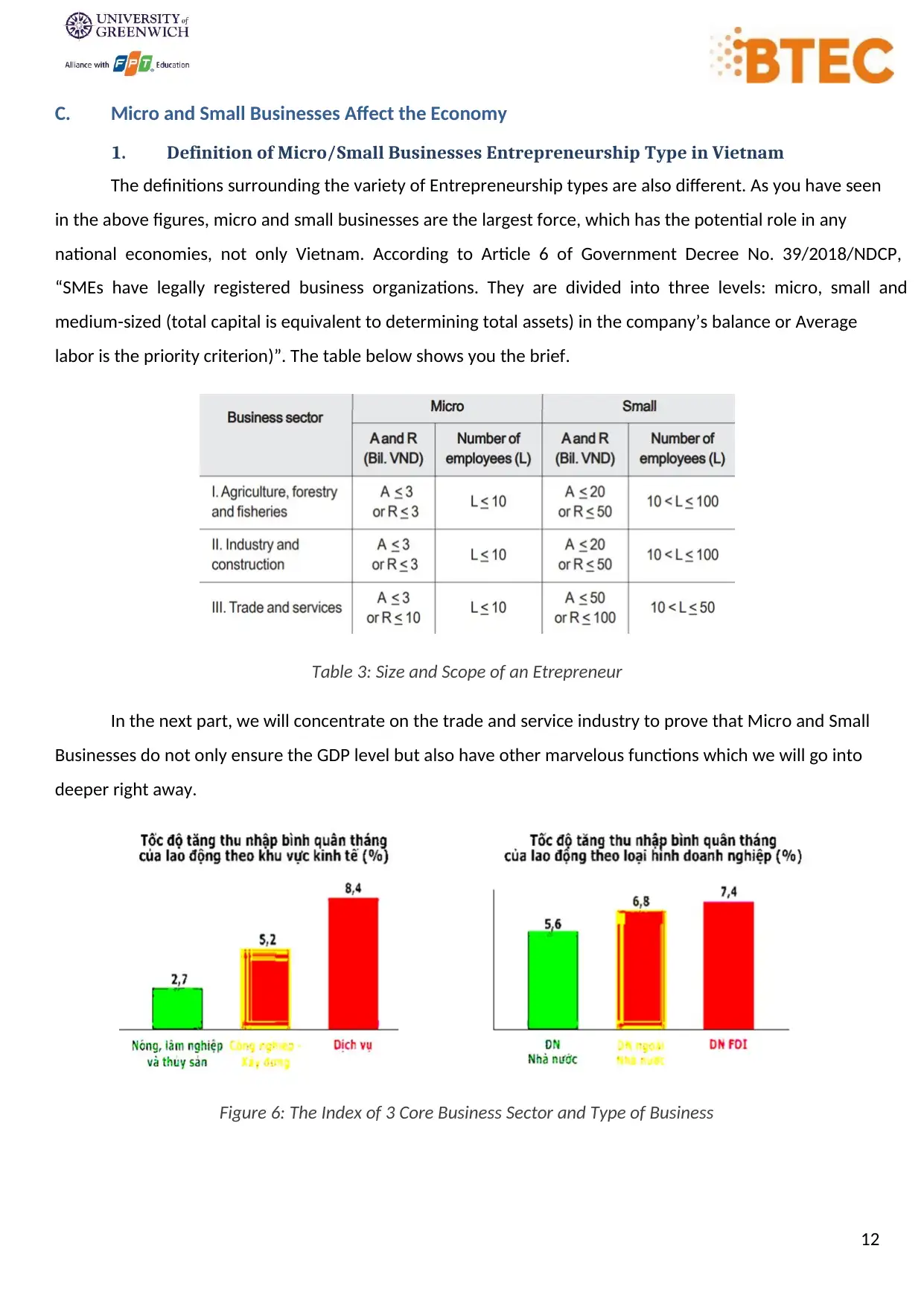
12
C. Micro and Small Businesses Affect the Economy
1. Definition of Micro/Small Businesses Entrepreneurship Type in Vietnam
The definitions surrounding the variety of Entrepreneurship types are also different. As you have seen
in the above figures, micro and small businesses are the largest force, which has the potential role in any
national economies, not only Vietnam. According to Article 6 of Government Decree No. 39/2018/NDCP,
“SMEs have legally registered business organizations. They are divided into three levels: micro, small and
medium-sized (total capital is equivalent to determining total assets) in the company’s balance or Average
labor is the priority criterion)”. The table below shows you the brief.
Table 3: Size and Scope of an Etrepreneur
In the next part, we will concentrate on the trade and service industry to prove that Micro and Small
Businesses do not only ensure the GDP level but also have other marvelous functions which we will go into
deeper right away.
Figure 6: The Index of 3 Core Business Sector and Type of Business
C. Micro and Small Businesses Affect the Economy
1. Definition of Micro/Small Businesses Entrepreneurship Type in Vietnam
The definitions surrounding the variety of Entrepreneurship types are also different. As you have seen
in the above figures, micro and small businesses are the largest force, which has the potential role in any
national economies, not only Vietnam. According to Article 6 of Government Decree No. 39/2018/NDCP,
“SMEs have legally registered business organizations. They are divided into three levels: micro, small and
medium-sized (total capital is equivalent to determining total assets) in the company’s balance or Average
labor is the priority criterion)”. The table below shows you the brief.
Table 3: Size and Scope of an Etrepreneur
In the next part, we will concentrate on the trade and service industry to prove that Micro and Small
Businesses do not only ensure the GDP level but also have other marvelous functions which we will go into
deeper right away.
Figure 6: The Index of 3 Core Business Sector and Type of Business
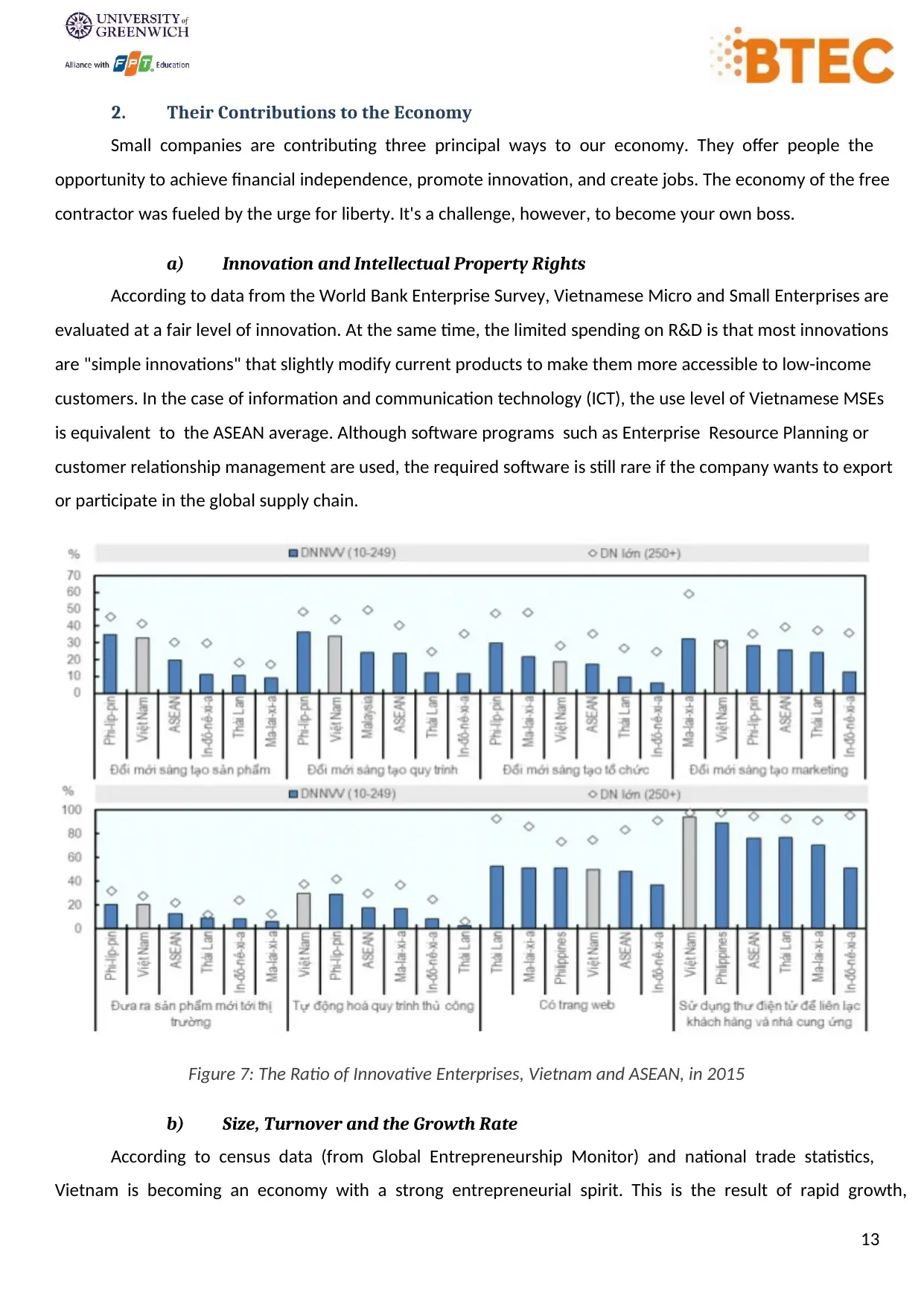
13
2. Their Contributions to the Economy
Small companies are contributing three principal ways to our economy. They offer people the
opportunity to achieve financial independence, promote innovation, and create jobs. The economy of the free
contractor was fueled by the urge for liberty. It's a challenge, however, to become your own boss.
a) Innovation and Intellectual Property Rights
According to data from the World Bank Enterprise Survey, Vietnamese Micro and Small Enterprises are
evaluated at a fair level of innovation. At the same time, the limited spending on R&D is that most innovations
are "simple innovations" that slightly modify current products to make them more accessible to low-income
customers. In the case of information and communication technology (ICT), the use level of Vietnamese MSEs
is equivalent to the ASEAN average. Although software programs such as Enterprise Resource Planning or
customer relationship management are used, the required software is still rare if the company wants to export
or participate in the global supply chain.
Figure 7: The Ratio of Innovative Enterprises, Vietnam and ASEAN, in 2015
b) Size, Turnover and the Growth Rate
According to census data (from Global Entrepreneurship Monitor) and national trade statistics,
Vietnam is becoming an economy with a strong entrepreneurial spirit. This is the result of rapid growth,
2. Their Contributions to the Economy
Small companies are contributing three principal ways to our economy. They offer people the
opportunity to achieve financial independence, promote innovation, and create jobs. The economy of the free
contractor was fueled by the urge for liberty. It's a challenge, however, to become your own boss.
a) Innovation and Intellectual Property Rights
According to data from the World Bank Enterprise Survey, Vietnamese Micro and Small Enterprises are
evaluated at a fair level of innovation. At the same time, the limited spending on R&D is that most innovations
are "simple innovations" that slightly modify current products to make them more accessible to low-income
customers. In the case of information and communication technology (ICT), the use level of Vietnamese MSEs
is equivalent to the ASEAN average. Although software programs such as Enterprise Resource Planning or
customer relationship management are used, the required software is still rare if the company wants to export
or participate in the global supply chain.
Figure 7: The Ratio of Innovative Enterprises, Vietnam and ASEAN, in 2015
b) Size, Turnover and the Growth Rate
According to census data (from Global Entrepreneurship Monitor) and national trade statistics,
Vietnam is becoming an economy with a strong entrepreneurial spirit. This is the result of rapid growth,
Paraphrase This Document
Need a fresh take? Get an instant paraphrase of this document with our AI Paraphraser
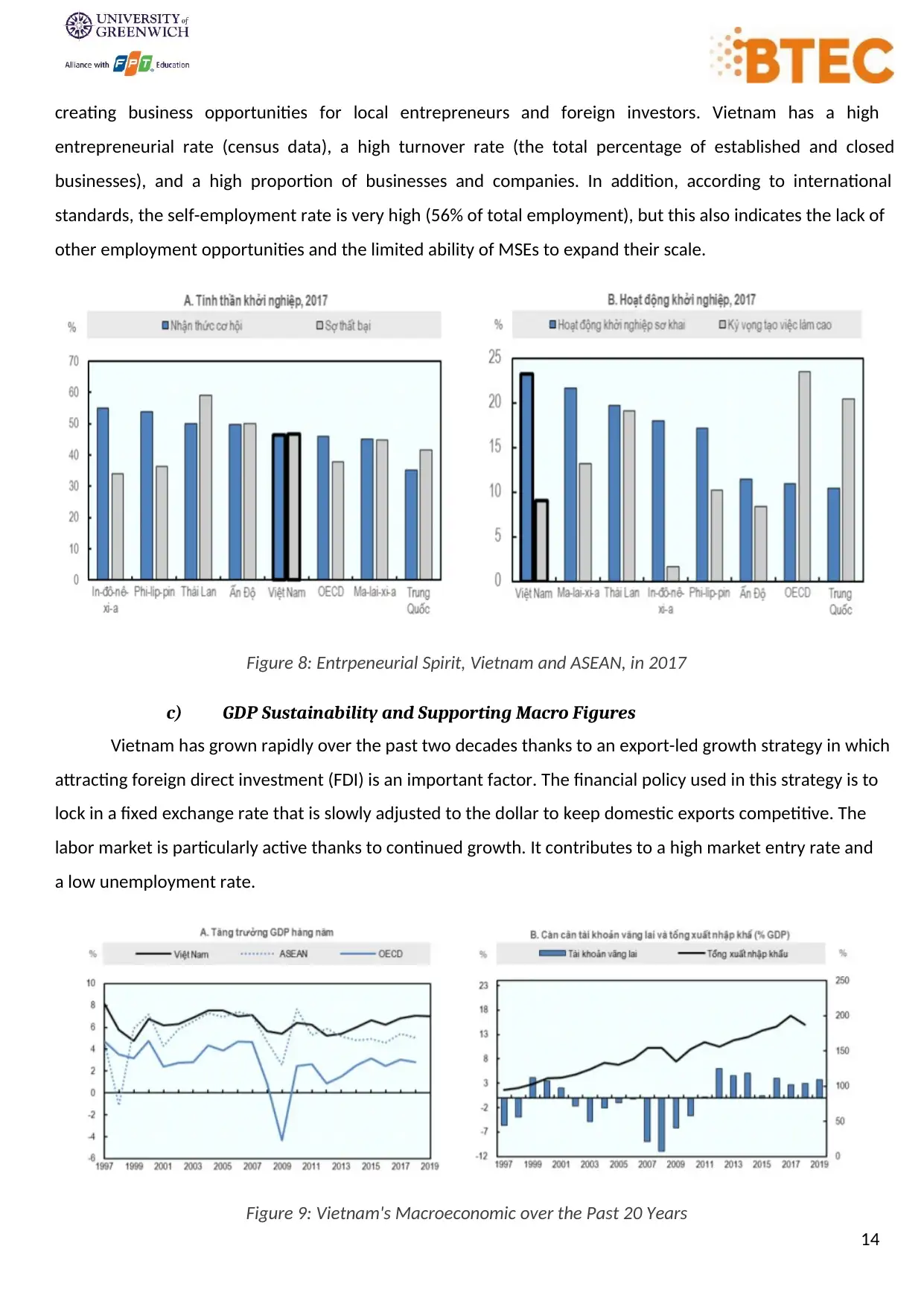
14
creating business opportunities for local entrepreneurs and foreign investors. Vietnam has a high
entrepreneurial rate (census data), a high turnover rate (the total percentage of established and closed
businesses), and a high proportion of businesses and companies. In addition, according to international
standards, the self-employment rate is very high (56% of total employment), but this also indicates the lack of
other employment opportunities and the limited ability of MSEs to expand their scale.
Figure 8: Entrpeneurial Spirit, Vietnam and ASEAN, in 2017
c) GDP Sustainability and Supporting Macro Figures
Vietnam has grown rapidly over the past two decades thanks to an export-led growth strategy in which
attracting foreign direct investment (FDI) is an important factor. The financial policy used in this strategy is to
lock in a fixed exchange rate that is slowly adjusted to the dollar to keep domestic exports competitive. The
labor market is particularly active thanks to continued growth. It contributes to a high market entry rate and
a low unemployment rate.
Figure 9: Vietnam's Macroeconomic over the Past 20 Years
creating business opportunities for local entrepreneurs and foreign investors. Vietnam has a high
entrepreneurial rate (census data), a high turnover rate (the total percentage of established and closed
businesses), and a high proportion of businesses and companies. In addition, according to international
standards, the self-employment rate is very high (56% of total employment), but this also indicates the lack of
other employment opportunities and the limited ability of MSEs to expand their scale.
Figure 8: Entrpeneurial Spirit, Vietnam and ASEAN, in 2017
c) GDP Sustainability and Supporting Macro Figures
Vietnam has grown rapidly over the past two decades thanks to an export-led growth strategy in which
attracting foreign direct investment (FDI) is an important factor. The financial policy used in this strategy is to
lock in a fixed exchange rate that is slowly adjusted to the dollar to keep domestic exports competitive. The
labor market is particularly active thanks to continued growth. It contributes to a high market entry rate and
a low unemployment rate.
Figure 9: Vietnam's Macroeconomic over the Past 20 Years
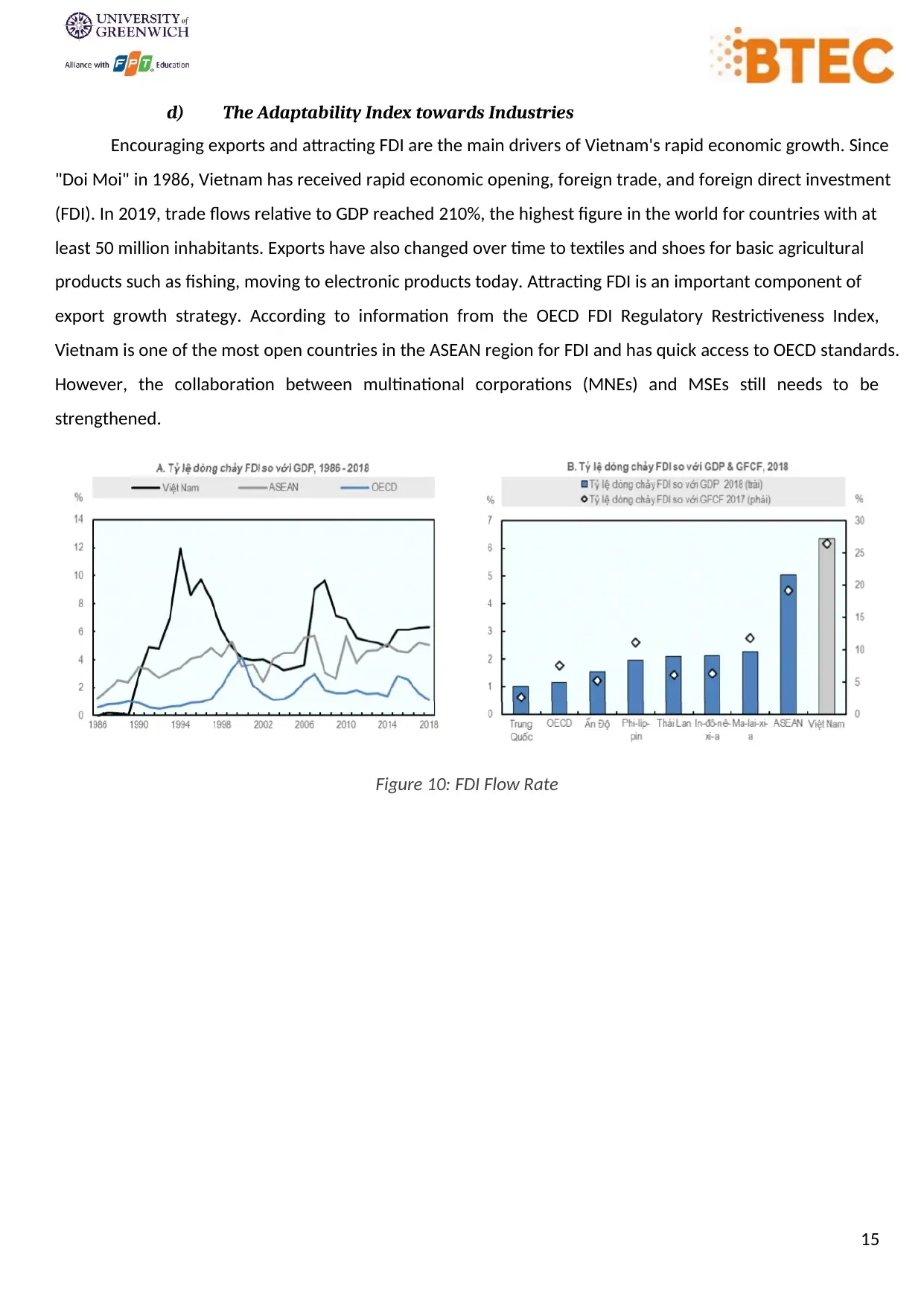
15
d) The Adaptability Index towards Industries
Encouraging exports and attracting FDI are the main drivers of Vietnam's rapid economic growth. Since
"Doi Moi" in 1986, Vietnam has received rapid economic opening, foreign trade, and foreign direct investment
(FDI). In 2019, trade flows relative to GDP reached 210%, the highest figure in the world for countries with at
least 50 million inhabitants. Exports have also changed over time to textiles and shoes for basic agricultural
products such as fishing, moving to electronic products today. Attracting FDI is an important component of
export growth strategy. According to information from the OECD FDI Regulatory Restrictiveness Index,
Vietnam is one of the most open countries in the ASEAN region for FDI and has quick access to OECD standards.
However, the collaboration between multinational corporations (MNEs) and MSEs still needs to be
strengthened.
Figure 10: FDI Flow Rate
d) The Adaptability Index towards Industries
Encouraging exports and attracting FDI are the main drivers of Vietnam's rapid economic growth. Since
"Doi Moi" in 1986, Vietnam has received rapid economic opening, foreign trade, and foreign direct investment
(FDI). In 2019, trade flows relative to GDP reached 210%, the highest figure in the world for countries with at
least 50 million inhabitants. Exports have also changed over time to textiles and shoes for basic agricultural
products such as fishing, moving to electronic products today. Attracting FDI is an important component of
export growth strategy. According to information from the OECD FDI Regulatory Restrictiveness Index,
Vietnam is one of the most open countries in the ASEAN region for FDI and has quick access to OECD standards.
However, the collaboration between multinational corporations (MNEs) and MSEs still needs to be
strengthened.
Figure 10: FDI Flow Rate
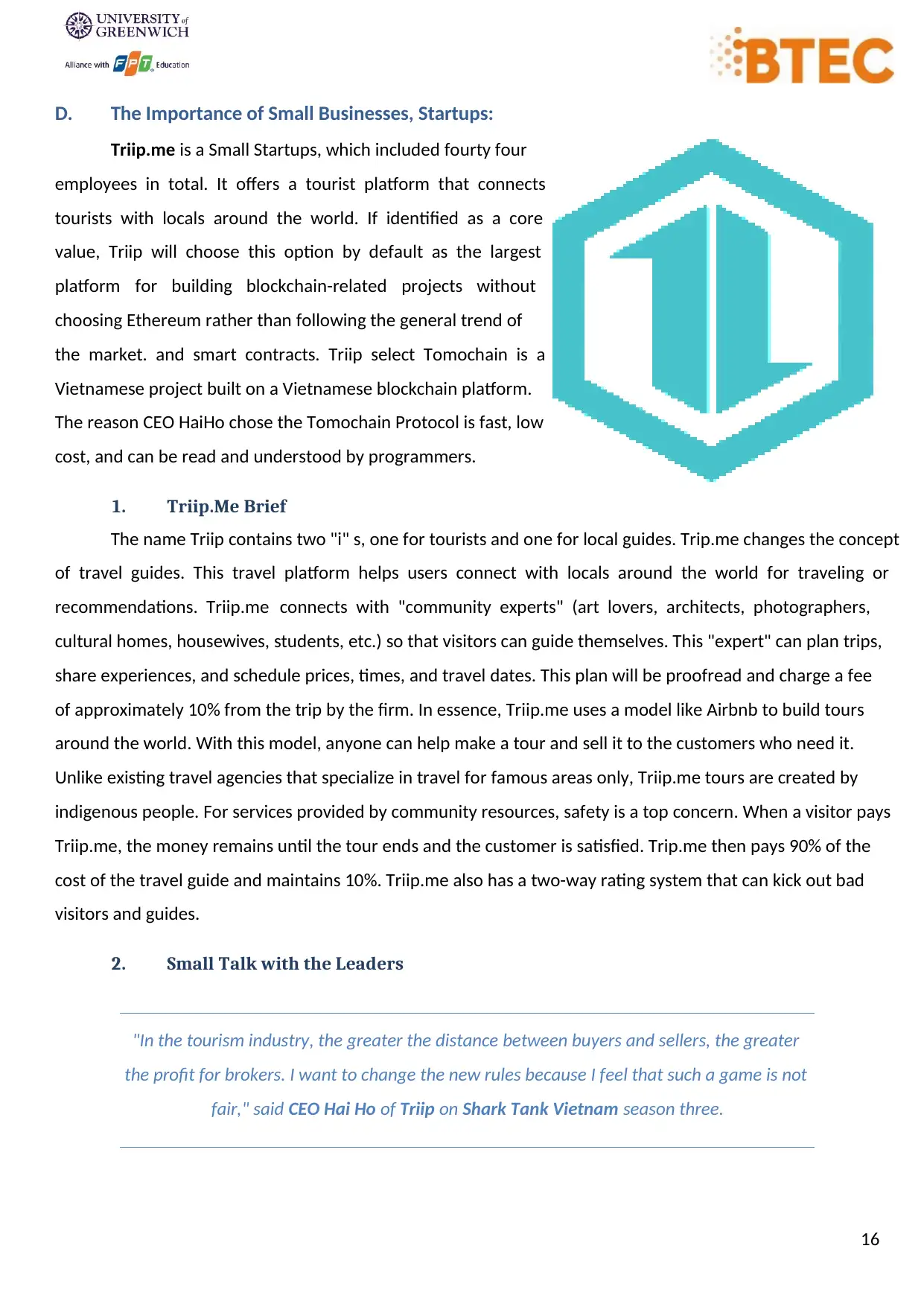
16
D. The Importance of Small Businesses, Startups:
Triip.me is a Small Startups, which included fourty four
employees in total. It offers a tourist platform that connects
tourists with locals around the world. If identified as a core
value, Triip will choose this option by default as the largest
platform for building blockchain-related projects without
choosing Ethereum rather than following the general trend of
the market. and smart contracts. Triip select Tomochain is a
Vietnamese project built on a Vietnamese blockchain platform.
The reason CEO HaiHo chose the Tomochain Protocol is fast, low
cost, and can be read and understood by programmers.
1. Triip.Me Brief
The name Triip contains two "i" s, one for tourists and one for local guides. Trip.me changes the concept
of travel guides. This travel platform helps users connect with locals around the world for traveling or
recommendations. Triip.me connects with "community experts" (art lovers, architects, photographers,
cultural homes, housewives, students, etc.) so that visitors can guide themselves. This "expert" can plan trips,
share experiences, and schedule prices, times, and travel dates. This plan will be proofread and charge a fee
of approximately 10% from the trip by the firm. In essence, Triip.me uses a model like Airbnb to build tours
around the world. With this model, anyone can help make a tour and sell it to the customers who need it.
Unlike existing travel agencies that specialize in travel for famous areas only, Triip.me tours are created by
indigenous people. For services provided by community resources, safety is a top concern. When a visitor pays
Triip.me, the money remains until the tour ends and the customer is satisfied. Trip.me then pays 90% of the
cost of the travel guide and maintains 10%. Triip.me also has a two-way rating system that can kick out bad
visitors and guides.
2. Small Talk with the Leaders
"In the tourism industry, the greater the distance between buyers and sellers, the greater
the profit for brokers. I want to change the new rules because I feel that such a game is not
fair," said CEO Hai Ho of Triip on Shark Tank Vietnam season three.
D. The Importance of Small Businesses, Startups:
Triip.me is a Small Startups, which included fourty four
employees in total. It offers a tourist platform that connects
tourists with locals around the world. If identified as a core
value, Triip will choose this option by default as the largest
platform for building blockchain-related projects without
choosing Ethereum rather than following the general trend of
the market. and smart contracts. Triip select Tomochain is a
Vietnamese project built on a Vietnamese blockchain platform.
The reason CEO HaiHo chose the Tomochain Protocol is fast, low
cost, and can be read and understood by programmers.
1. Triip.Me Brief
The name Triip contains two "i" s, one for tourists and one for local guides. Trip.me changes the concept
of travel guides. This travel platform helps users connect with locals around the world for traveling or
recommendations. Triip.me connects with "community experts" (art lovers, architects, photographers,
cultural homes, housewives, students, etc.) so that visitors can guide themselves. This "expert" can plan trips,
share experiences, and schedule prices, times, and travel dates. This plan will be proofread and charge a fee
of approximately 10% from the trip by the firm. In essence, Triip.me uses a model like Airbnb to build tours
around the world. With this model, anyone can help make a tour and sell it to the customers who need it.
Unlike existing travel agencies that specialize in travel for famous areas only, Triip.me tours are created by
indigenous people. For services provided by community resources, safety is a top concern. When a visitor pays
Triip.me, the money remains until the tour ends and the customer is satisfied. Trip.me then pays 90% of the
cost of the travel guide and maintains 10%. Triip.me also has a two-way rating system that can kick out bad
visitors and guides.
2. Small Talk with the Leaders
"In the tourism industry, the greater the distance between buyers and sellers, the greater
the profit for brokers. I want to change the new rules because I feel that such a game is not
fair," said CEO Hai Ho of Triip on Shark Tank Vietnam season three.
Secure Best Marks with AI Grader
Need help grading? Try our AI Grader for instant feedback on your assignments.
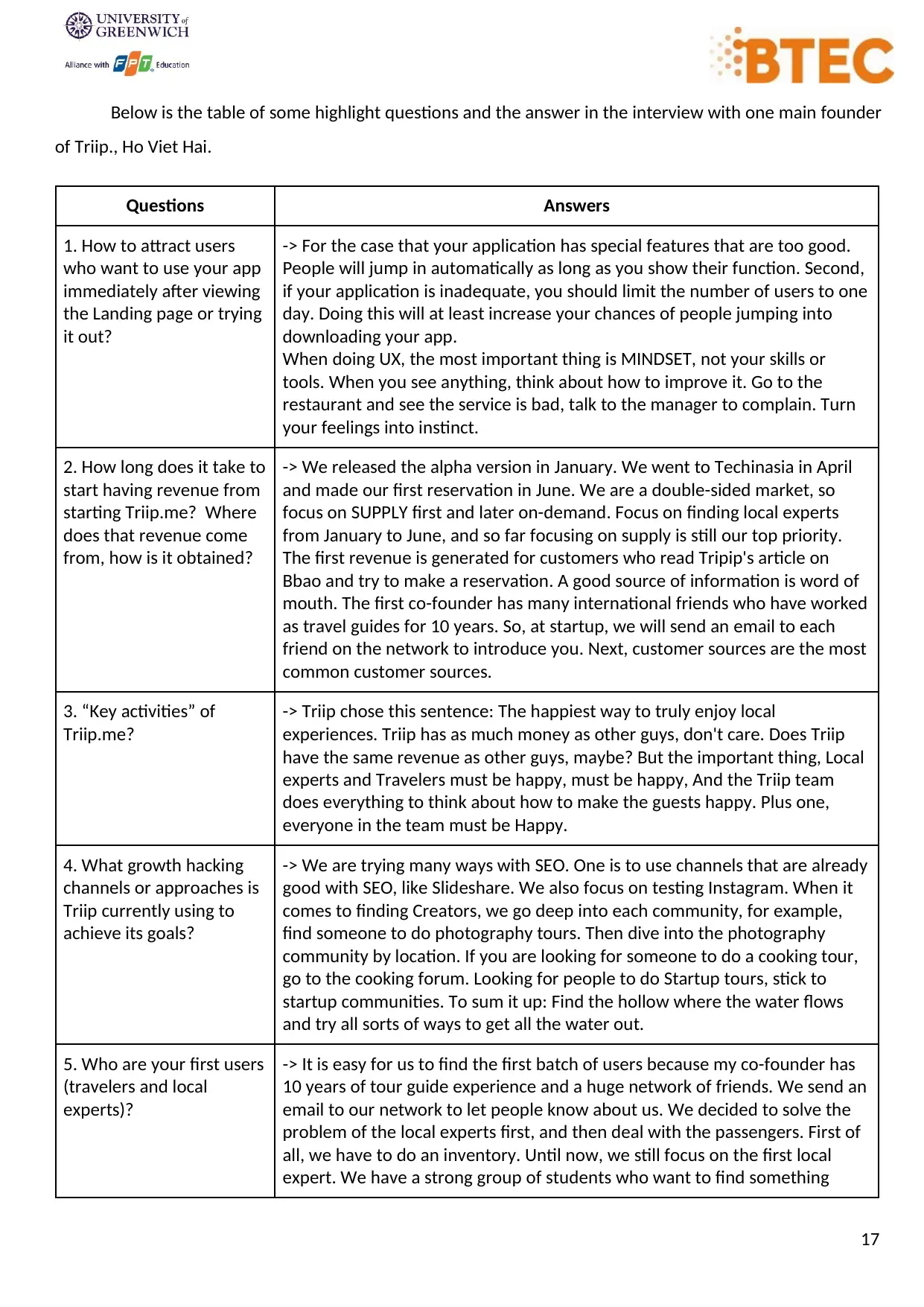
17
Below is the table of some highlight questions and the answer in the interview with one main founder
of Triip., Ho Viet Hai.
Questions Answers
1. How to attract users
who want to use your app
immediately after viewing
the Landing page or trying
it out?
-> For the case that your application has special features that are too good.
People will jump in automatically as long as you show their function. Second,
if your application is inadequate, you should limit the number of users to one
day. Doing this will at least increase your chances of people jumping into
downloading your app.
When doing UX, the most important thing is MINDSET, not your skills or
tools. When you see anything, think about how to improve it. Go to the
restaurant and see the service is bad, talk to the manager to complain. Turn
your feelings into instinct.
2. How long does it take to
start having revenue from
starting Triip.me? Where
does that revenue come
from, how is it obtained?
-> We released the alpha version in January. We went to Techinasia in April
and made our first reservation in June. We are a double-sided market, so
focus on SUPPLY first and later on-demand. Focus on finding local experts
from January to June, and so far focusing on supply is still our top priority.
The first revenue is generated for customers who read Tripip's article on
Bbao and try to make a reservation. A good source of information is word of
mouth. The first co-founder has many international friends who have worked
as travel guides for 10 years. So, at startup, we will send an email to each
friend on the network to introduce you. Next, customer sources are the most
common customer sources.
3. “Key activities” of
Triip.me?
-> Triip chose this sentence: The happiest way to truly enjoy local
experiences. Triip has as much money as other guys, don't care. Does Triip
have the same revenue as other guys, maybe? But the important thing, Local
experts and Travelers must be happy, must be happy, And the Triip team
does everything to think about how to make the guests happy. Plus one,
everyone in the team must be Happy.
4. What growth hacking
channels or approaches is
Triip currently using to
achieve its goals?
-> We are trying many ways with SEO. One is to use channels that are already
good with SEO, like Slideshare. We also focus on testing Instagram. When it
comes to finding Creators, we go deep into each community, for example,
find someone to do photography tours. Then dive into the photography
community by location. If you are looking for someone to do a cooking tour,
go to the cooking forum. Looking for people to do Startup tours, stick to
startup communities. To sum it up: Find the hollow where the water flows
and try all sorts of ways to get all the water out.
5. Who are your first users
(travelers and local
experts)?
-> It is easy for us to find the first batch of users because my co-founder has
10 years of tour guide experience and a huge network of friends. We send an
email to our network to let people know about us. We decided to solve the
problem of the local experts first, and then deal with the passengers. First of
all, we have to do an inventory. Until now, we still focus on the first local
expert. We have a strong group of students who want to find something
Below is the table of some highlight questions and the answer in the interview with one main founder
of Triip., Ho Viet Hai.
Questions Answers
1. How to attract users
who want to use your app
immediately after viewing
the Landing page or trying
it out?
-> For the case that your application has special features that are too good.
People will jump in automatically as long as you show their function. Second,
if your application is inadequate, you should limit the number of users to one
day. Doing this will at least increase your chances of people jumping into
downloading your app.
When doing UX, the most important thing is MINDSET, not your skills or
tools. When you see anything, think about how to improve it. Go to the
restaurant and see the service is bad, talk to the manager to complain. Turn
your feelings into instinct.
2. How long does it take to
start having revenue from
starting Triip.me? Where
does that revenue come
from, how is it obtained?
-> We released the alpha version in January. We went to Techinasia in April
and made our first reservation in June. We are a double-sided market, so
focus on SUPPLY first and later on-demand. Focus on finding local experts
from January to June, and so far focusing on supply is still our top priority.
The first revenue is generated for customers who read Tripip's article on
Bbao and try to make a reservation. A good source of information is word of
mouth. The first co-founder has many international friends who have worked
as travel guides for 10 years. So, at startup, we will send an email to each
friend on the network to introduce you. Next, customer sources are the most
common customer sources.
3. “Key activities” of
Triip.me?
-> Triip chose this sentence: The happiest way to truly enjoy local
experiences. Triip has as much money as other guys, don't care. Does Triip
have the same revenue as other guys, maybe? But the important thing, Local
experts and Travelers must be happy, must be happy, And the Triip team
does everything to think about how to make the guests happy. Plus one,
everyone in the team must be Happy.
4. What growth hacking
channels or approaches is
Triip currently using to
achieve its goals?
-> We are trying many ways with SEO. One is to use channels that are already
good with SEO, like Slideshare. We also focus on testing Instagram. When it
comes to finding Creators, we go deep into each community, for example,
find someone to do photography tours. Then dive into the photography
community by location. If you are looking for someone to do a cooking tour,
go to the cooking forum. Looking for people to do Startup tours, stick to
startup communities. To sum it up: Find the hollow where the water flows
and try all sorts of ways to get all the water out.
5. Who are your first users
(travelers and local
experts)?
-> It is easy for us to find the first batch of users because my co-founder has
10 years of tour guide experience and a huge network of friends. We send an
email to our network to let people know about us. We decided to solve the
problem of the local experts first, and then deal with the passengers. First of
all, we have to do an inventory. Until now, we still focus on the first local
expert. We have a strong group of students who want to find something
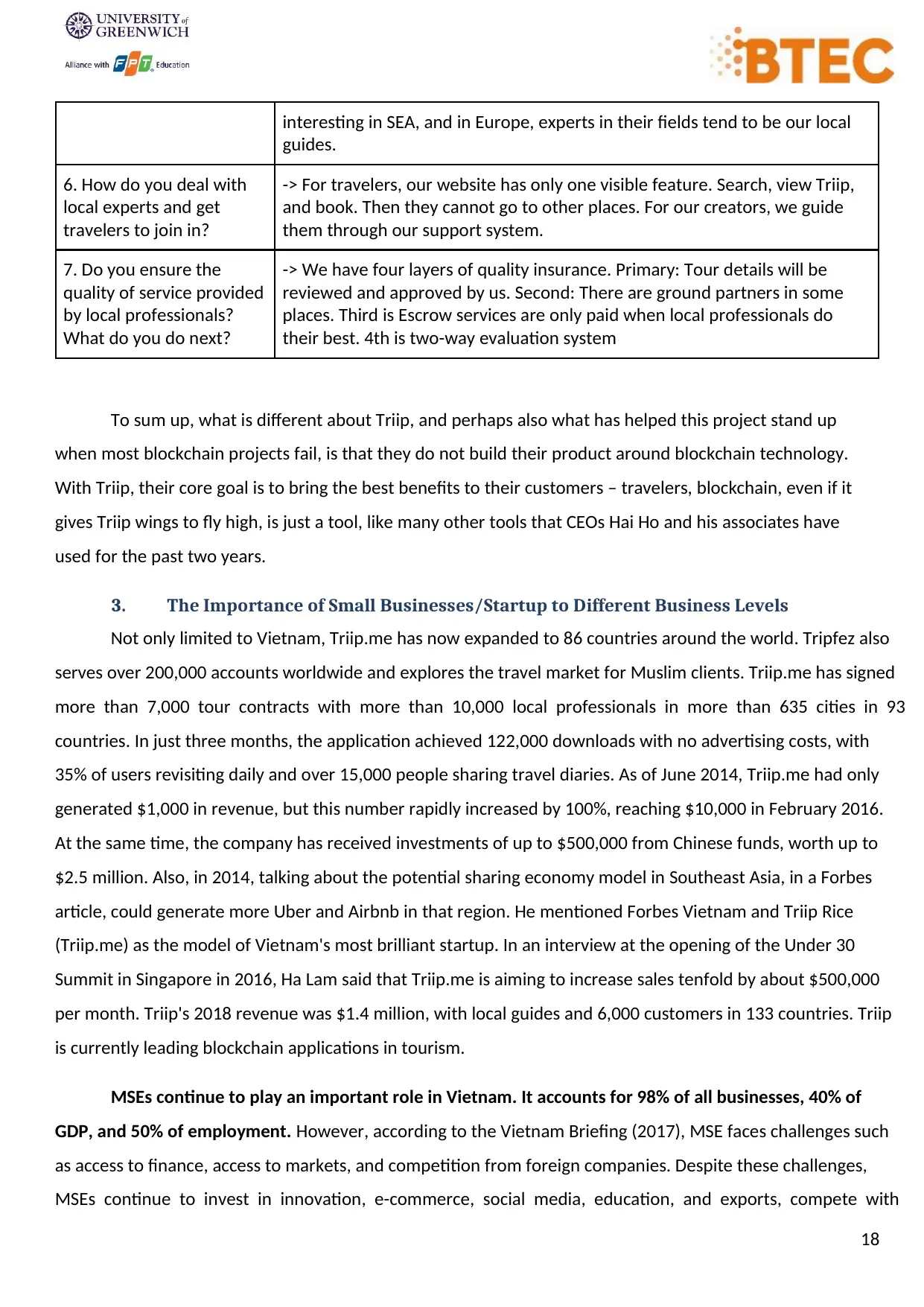
18
interesting in SEA, and in Europe, experts in their fields tend to be our local
guides.
6. How do you deal with
local experts and get
travelers to join in?
-> For travelers, our website has only one visible feature. Search, view Triip,
and book. Then they cannot go to other places. For our creators, we guide
them through our support system.
7. Do you ensure the
quality of service provided
by local professionals?
What do you do next?
-> We have four layers of quality insurance. Primary: Tour details will be
reviewed and approved by us. Second: There are ground partners in some
places. Third is Escrow services are only paid when local professionals do
their best. 4th is two-way evaluation system
To sum up, what is different about Triip, and perhaps also what has helped this project stand up
when most blockchain projects fail, is that they do not build their product around blockchain technology.
With Triip, their core goal is to bring the best benefits to their customers – travelers, blockchain, even if it
gives Triip wings to fly high, is just a tool, like many other tools that CEOs Hai Ho and his associates have
used for the past two years.
3. The Importance of Small Businesses/Startup to Different Business Levels
Not only limited to Vietnam, Triip.me has now expanded to 86 countries around the world. Tripfez also
serves over 200,000 accounts worldwide and explores the travel market for Muslim clients. Triip.me has signed
more than 7,000 tour contracts with more than 10,000 local professionals in more than 635 cities in 93
countries. In just three months, the application achieved 122,000 downloads with no advertising costs, with
35% of users revisiting daily and over 15,000 people sharing travel diaries. As of June 2014, Triip.me had only
generated $1,000 in revenue, but this number rapidly increased by 100%, reaching $10,000 in February 2016.
At the same time, the company has received investments of up to $500,000 from Chinese funds, worth up to
$2.5 million. Also, in 2014, talking about the potential sharing economy model in Southeast Asia, in a Forbes
article, could generate more Uber and Airbnb in that region. He mentioned Forbes Vietnam and Triip Rice
(Triip.me) as the model of Vietnam's most brilliant startup. In an interview at the opening of the Under 30
Summit in Singapore in 2016, Ha Lam said that Triip.me is aiming to increase sales tenfold by about $500,000
per month. Triip's 2018 revenue was $1.4 million, with local guides and 6,000 customers in 133 countries. Triip
is currently leading blockchain applications in tourism.
MSEs continue to play an important role in Vietnam. It accounts for 98% of all businesses, 40% of
GDP, and 50% of employment. However, according to the Vietnam Briefing (2017), MSE faces challenges such
as access to finance, access to markets, and competition from foreign companies. Despite these challenges,
MSEs continue to invest in innovation, e-commerce, social media, education, and exports, compete with
interesting in SEA, and in Europe, experts in their fields tend to be our local
guides.
6. How do you deal with
local experts and get
travelers to join in?
-> For travelers, our website has only one visible feature. Search, view Triip,
and book. Then they cannot go to other places. For our creators, we guide
them through our support system.
7. Do you ensure the
quality of service provided
by local professionals?
What do you do next?
-> We have four layers of quality insurance. Primary: Tour details will be
reviewed and approved by us. Second: There are ground partners in some
places. Third is Escrow services are only paid when local professionals do
their best. 4th is two-way evaluation system
To sum up, what is different about Triip, and perhaps also what has helped this project stand up
when most blockchain projects fail, is that they do not build their product around blockchain technology.
With Triip, their core goal is to bring the best benefits to their customers – travelers, blockchain, even if it
gives Triip wings to fly high, is just a tool, like many other tools that CEOs Hai Ho and his associates have
used for the past two years.
3. The Importance of Small Businesses/Startup to Different Business Levels
Not only limited to Vietnam, Triip.me has now expanded to 86 countries around the world. Tripfez also
serves over 200,000 accounts worldwide and explores the travel market for Muslim clients. Triip.me has signed
more than 7,000 tour contracts with more than 10,000 local professionals in more than 635 cities in 93
countries. In just three months, the application achieved 122,000 downloads with no advertising costs, with
35% of users revisiting daily and over 15,000 people sharing travel diaries. As of June 2014, Triip.me had only
generated $1,000 in revenue, but this number rapidly increased by 100%, reaching $10,000 in February 2016.
At the same time, the company has received investments of up to $500,000 from Chinese funds, worth up to
$2.5 million. Also, in 2014, talking about the potential sharing economy model in Southeast Asia, in a Forbes
article, could generate more Uber and Airbnb in that region. He mentioned Forbes Vietnam and Triip Rice
(Triip.me) as the model of Vietnam's most brilliant startup. In an interview at the opening of the Under 30
Summit in Singapore in 2016, Ha Lam said that Triip.me is aiming to increase sales tenfold by about $500,000
per month. Triip's 2018 revenue was $1.4 million, with local guides and 6,000 customers in 133 countries. Triip
is currently leading blockchain applications in tourism.
MSEs continue to play an important role in Vietnam. It accounts for 98% of all businesses, 40% of
GDP, and 50% of employment. However, according to the Vietnam Briefing (2017), MSE faces challenges such
as access to finance, access to markets, and competition from foreign companies. Despite these challenges,
MSEs continue to invest in innovation, e-commerce, social media, education, and exports, compete with
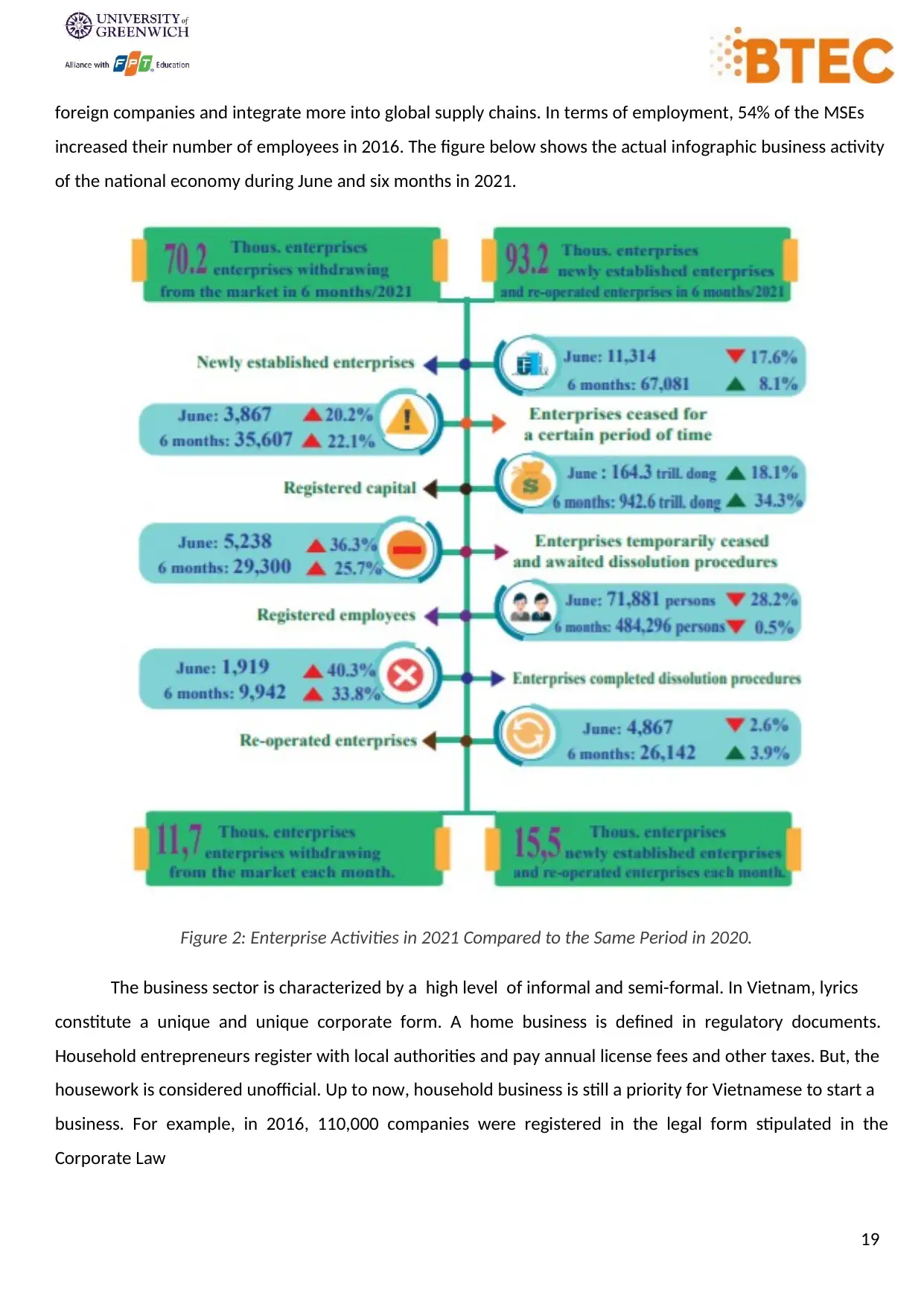
19
foreign companies and integrate more into global supply chains. In terms of employment, 54% of the MSEs
increased their number of employees in 2016. The figure below shows the actual infographic business activity
of the national economy during June and six months in 2021.
Figure 2: Enterprise Activities in 2021 Compared to the Same Period in 2020.
The business sector is characterized by a high level of informal and semi-formal. In Vietnam, lyrics
constitute a unique and unique corporate form. A home business is defined in regulatory documents.
Household entrepreneurs register with local authorities and pay annual license fees and other taxes. But, the
housework is considered unofficial. Up to now, household business is still a priority for Vietnamese to start a
business. For example, in 2016, 110,000 companies were registered in the legal form stipulated in the
Corporate Law
foreign companies and integrate more into global supply chains. In terms of employment, 54% of the MSEs
increased their number of employees in 2016. The figure below shows the actual infographic business activity
of the national economy during June and six months in 2021.
Figure 2: Enterprise Activities in 2021 Compared to the Same Period in 2020.
The business sector is characterized by a high level of informal and semi-formal. In Vietnam, lyrics
constitute a unique and unique corporate form. A home business is defined in regulatory documents.
Household entrepreneurs register with local authorities and pay annual license fees and other taxes. But, the
housework is considered unofficial. Up to now, household business is still a priority for Vietnamese to start a
business. For example, in 2016, 110,000 companies were registered in the legal form stipulated in the
Corporate Law
Paraphrase This Document
Need a fresh take? Get an instant paraphrase of this document with our AI Paraphraser

20
III. Conclusion:
To sum up, all that we have mentioned, I can say that micro and small enterprises in Vietnam play a
vital role not only at the local level but also at the national and international level. Global. From the above
analysis, it is potential to develop more practices or policies. The purpose is to encourage Vietnamese people
to participate in building the country's society and future generations.
III. Conclusion:
To sum up, all that we have mentioned, I can say that micro and small enterprises in Vietnam play a
vital role not only at the local level but also at the national and international level. Global. From the above
analysis, it is potential to develop more practices or policies. The purpose is to encourage Vietnamese people
to participate in building the country's society and future generations.
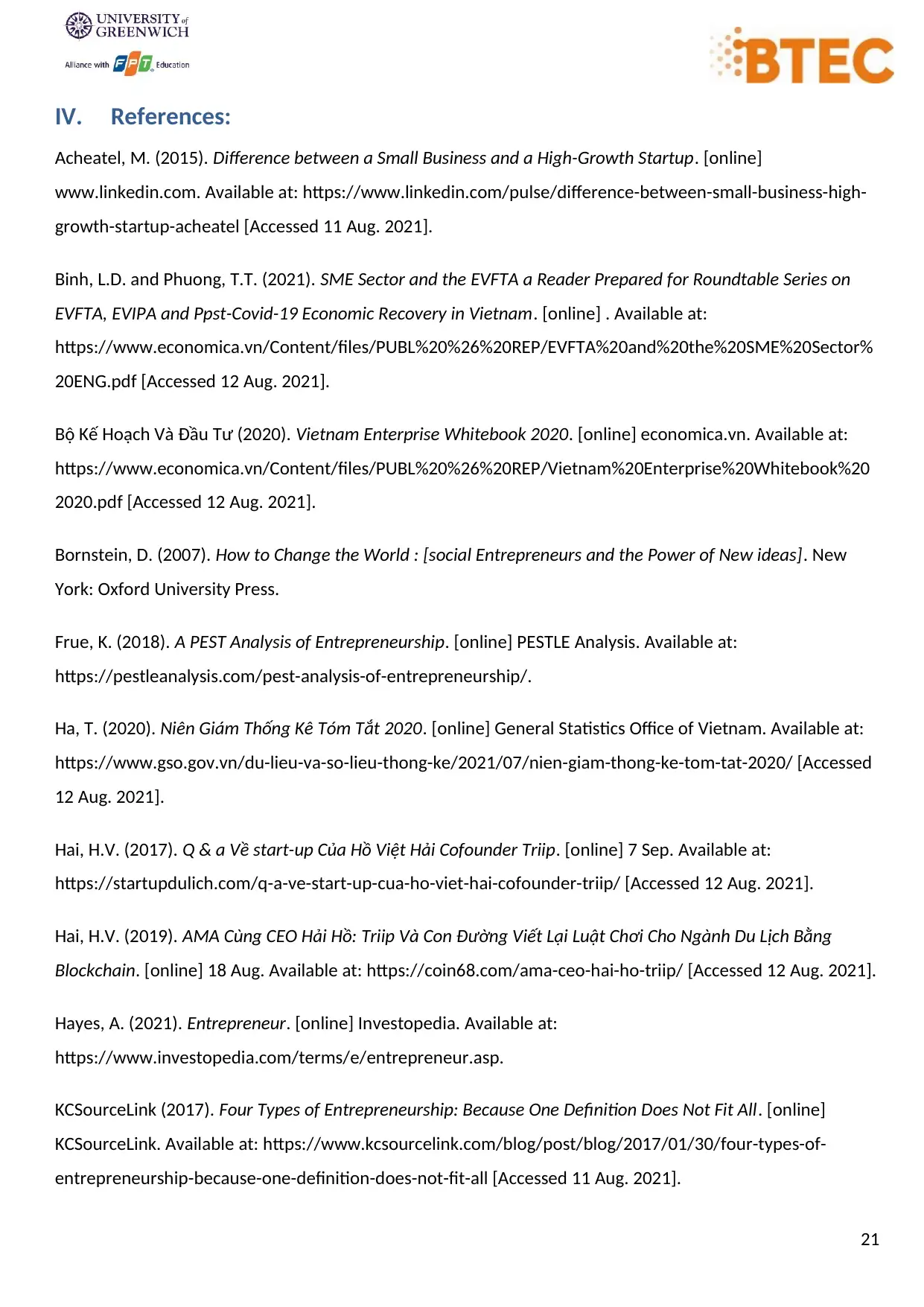
21
IV. References:
Acheatel, M. (2015). Difference between a Small Business and a High-Growth Startup. [online]
www.linkedin.com. Available at: https://www.linkedin.com/pulse/difference-between-small-business-high-
growth-startup-acheatel [Accessed 11 Aug. 2021].
Binh, L.D. and Phuong, T.T. (2021). SME Sector and the EVFTA a Reader Prepared for Roundtable Series on
EVFTA, EVIPA and Ppst-Covid-19 Economic Recovery in Vietnam. [online] . Available at:
https://www.economica.vn/Content/files/PUBL%20%26%20REP/EVFTA%20and%20the%20SME%20Sector%
20ENG.pdf [Accessed 12 Aug. 2021].
Bộ Kế Hoạch Và Đầu Tư (2020). Vietnam Enterprise Whitebook 2020. [online] economica.vn. Available at:
https://www.economica.vn/Content/files/PUBL%20%26%20REP/Vietnam%20Enterprise%20Whitebook%20
2020.pdf [Accessed 12 Aug. 2021].
Bornstein, D. (2007). How to Change the World : [social Entrepreneurs and the Power of New ideas]. New
York: Oxford University Press.
Frue, K. (2018). A PEST Analysis of Entrepreneurship. [online] PESTLE Analysis. Available at:
https://pestleanalysis.com/pest-analysis-of-entrepreneurship/.
Ha, T. (2020). Niên Giám Thống Kê Tóm Tắt 2020. [online] General Statistics Office of Vietnam. Available at:
https://www.gso.gov.vn/du-lieu-va-so-lieu-thong-ke/2021/07/nien-giam-thong-ke-tom-tat-2020/ [Accessed
12 Aug. 2021].
Hai, H.V. (2017). Q & a Về start-up Của Hồ Việt Hải Cofounder Triip. [online] 7 Sep. Available at:
https://startupdulich.com/q-a-ve-start-up-cua-ho-viet-hai-cofounder-triip/ [Accessed 12 Aug. 2021].
Hai, H.V. (2019). AMA Cùng CEO Hải Hồ: Triip Và Con Đường Viết Lại Luật Chơi Cho Ngành Du Lịch Bằng
Blockchain. [online] 18 Aug. Available at: https://coin68.com/ama-ceo-hai-ho-triip/ [Accessed 12 Aug. 2021].
Hayes, A. (2021). Entrepreneur. [online] Investopedia. Available at:
https://www.investopedia.com/terms/e/entrepreneur.asp.
KCSourceLink (2017). Four Types of Entrepreneurship: Because One Definition Does Not Fit All. [online]
KCSourceLink. Available at: https://www.kcsourcelink.com/blog/post/blog/2017/01/30/four-types-of-
entrepreneurship-because-one-definition-does-not-fit-all [Accessed 11 Aug. 2021].
IV. References:
Acheatel, M. (2015). Difference between a Small Business and a High-Growth Startup. [online]
www.linkedin.com. Available at: https://www.linkedin.com/pulse/difference-between-small-business-high-
growth-startup-acheatel [Accessed 11 Aug. 2021].
Binh, L.D. and Phuong, T.T. (2021). SME Sector and the EVFTA a Reader Prepared for Roundtable Series on
EVFTA, EVIPA and Ppst-Covid-19 Economic Recovery in Vietnam. [online] . Available at:
https://www.economica.vn/Content/files/PUBL%20%26%20REP/EVFTA%20and%20the%20SME%20Sector%
20ENG.pdf [Accessed 12 Aug. 2021].
Bộ Kế Hoạch Và Đầu Tư (2020). Vietnam Enterprise Whitebook 2020. [online] economica.vn. Available at:
https://www.economica.vn/Content/files/PUBL%20%26%20REP/Vietnam%20Enterprise%20Whitebook%20
2020.pdf [Accessed 12 Aug. 2021].
Bornstein, D. (2007). How to Change the World : [social Entrepreneurs and the Power of New ideas]. New
York: Oxford University Press.
Frue, K. (2018). A PEST Analysis of Entrepreneurship. [online] PESTLE Analysis. Available at:
https://pestleanalysis.com/pest-analysis-of-entrepreneurship/.
Ha, T. (2020). Niên Giám Thống Kê Tóm Tắt 2020. [online] General Statistics Office of Vietnam. Available at:
https://www.gso.gov.vn/du-lieu-va-so-lieu-thong-ke/2021/07/nien-giam-thong-ke-tom-tat-2020/ [Accessed
12 Aug. 2021].
Hai, H.V. (2017). Q & a Về start-up Của Hồ Việt Hải Cofounder Triip. [online] 7 Sep. Available at:
https://startupdulich.com/q-a-ve-start-up-cua-ho-viet-hai-cofounder-triip/ [Accessed 12 Aug. 2021].
Hai, H.V. (2019). AMA Cùng CEO Hải Hồ: Triip Và Con Đường Viết Lại Luật Chơi Cho Ngành Du Lịch Bằng
Blockchain. [online] 18 Aug. Available at: https://coin68.com/ama-ceo-hai-ho-triip/ [Accessed 12 Aug. 2021].
Hayes, A. (2021). Entrepreneur. [online] Investopedia. Available at:
https://www.investopedia.com/terms/e/entrepreneur.asp.
KCSourceLink (2017). Four Types of Entrepreneurship: Because One Definition Does Not Fit All. [online]
KCSourceLink. Available at: https://www.kcsourcelink.com/blog/post/blog/2017/01/30/four-types-of-
entrepreneurship-because-one-definition-does-not-fit-all [Accessed 11 Aug. 2021].
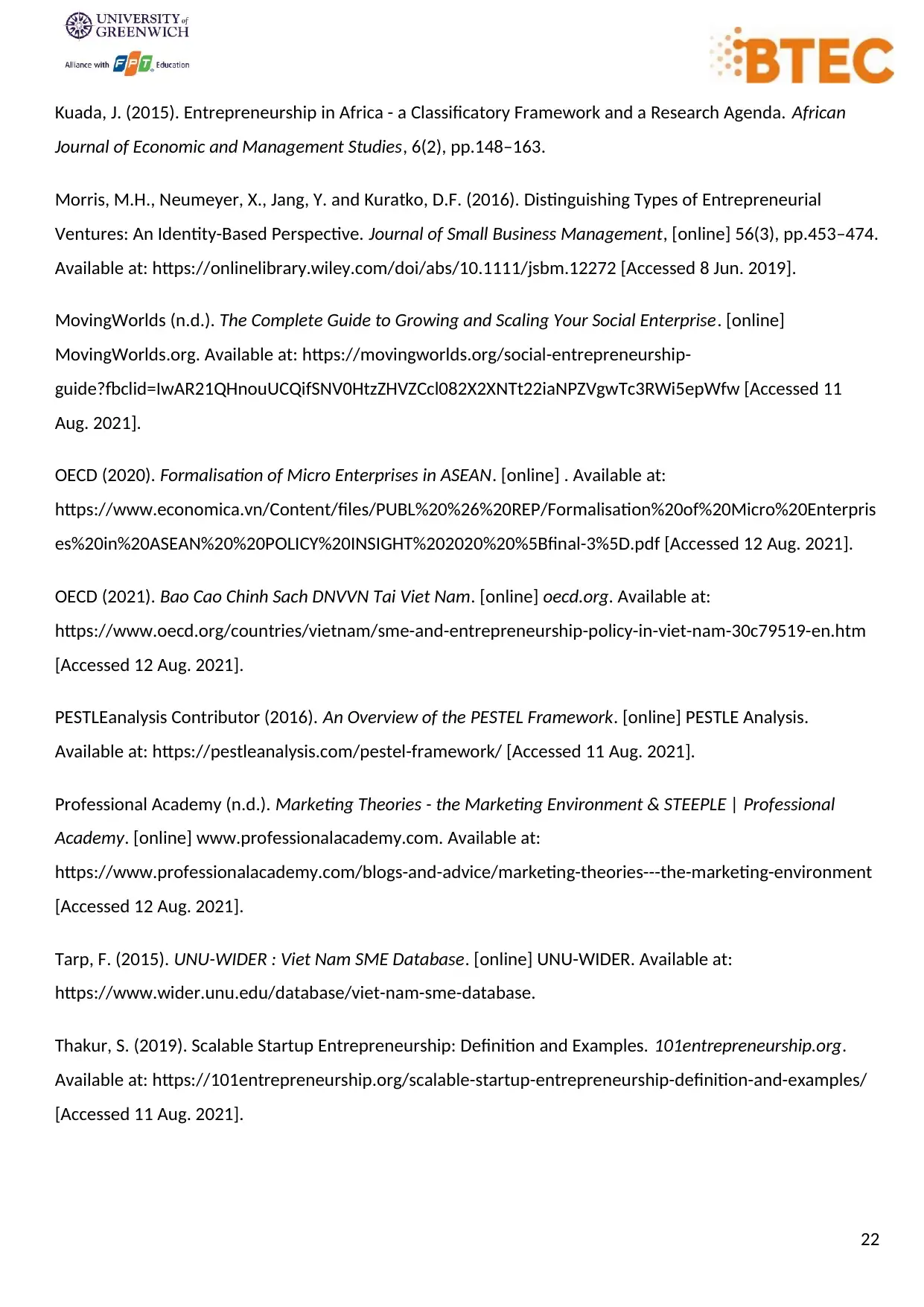
22
Kuada, J. (2015). Entrepreneurship in Africa - a Classificatory Framework and a Research Agenda. African
Journal of Economic and Management Studies, 6(2), pp.148–163.
Morris, M.H., Neumeyer, X., Jang, Y. and Kuratko, D.F. (2016). Distinguishing Types of Entrepreneurial
Ventures: An Identity-Based Perspective. Journal of Small Business Management, [online] 56(3), pp.453–474.
Available at: https://onlinelibrary.wiley.com/doi/abs/10.1111/jsbm.12272 [Accessed 8 Jun. 2019].
MovingWorlds (n.d.). The Complete Guide to Growing and Scaling Your Social Enterprise. [online]
MovingWorlds.org. Available at: https://movingworlds.org/social-entrepreneurship-
guide?fbclid=IwAR21QHnouUCQifSNV0HtzZHVZCcl082X2XNTt22iaNPZVgwTc3RWi5epWfw [Accessed 11
Aug. 2021].
OECD (2020). Formalisation of Micro Enterprises in ASEAN. [online] . Available at:
https://www.economica.vn/Content/files/PUBL%20%26%20REP/Formalisation%20of%20Micro%20Enterpris
es%20in%20ASEAN%20%20POLICY%20INSIGHT%202020%20%5Bfinal-3%5D.pdf [Accessed 12 Aug. 2021].
OECD (2021). Bao Cao Chinh Sach DNVVN Tai Viet Nam. [online] oecd.org. Available at:
https://www.oecd.org/countries/vietnam/sme-and-entrepreneurship-policy-in-viet-nam-30c79519-en.htm
[Accessed 12 Aug. 2021].
PESTLEanalysis Contributor (2016). An Overview of the PESTEL Framework. [online] PESTLE Analysis.
Available at: https://pestleanalysis.com/pestel-framework/ [Accessed 11 Aug. 2021].
Professional Academy (n.d.). Marketing Theories - the Marketing Environment & STEEPLE | Professional
Academy. [online] www.professionalacademy.com. Available at:
https://www.professionalacademy.com/blogs-and-advice/marketing-theories---the-marketing-environment
[Accessed 12 Aug. 2021].
Tarp, F. (2015). UNU-WIDER : Viet Nam SME Database. [online] UNU-WIDER. Available at:
https://www.wider.unu.edu/database/viet-nam-sme-database.
Thakur, S. (2019). Scalable Startup Entrepreneurship: Definition and Examples. 101entrepreneurship.org.
Available at: https://101entrepreneurship.org/scalable-startup-entrepreneurship-definition-and-examples/
[Accessed 11 Aug. 2021].
Kuada, J. (2015). Entrepreneurship in Africa - a Classificatory Framework and a Research Agenda. African
Journal of Economic and Management Studies, 6(2), pp.148–163.
Morris, M.H., Neumeyer, X., Jang, Y. and Kuratko, D.F. (2016). Distinguishing Types of Entrepreneurial
Ventures: An Identity-Based Perspective. Journal of Small Business Management, [online] 56(3), pp.453–474.
Available at: https://onlinelibrary.wiley.com/doi/abs/10.1111/jsbm.12272 [Accessed 8 Jun. 2019].
MovingWorlds (n.d.). The Complete Guide to Growing and Scaling Your Social Enterprise. [online]
MovingWorlds.org. Available at: https://movingworlds.org/social-entrepreneurship-
guide?fbclid=IwAR21QHnouUCQifSNV0HtzZHVZCcl082X2XNTt22iaNPZVgwTc3RWi5epWfw [Accessed 11
Aug. 2021].
OECD (2020). Formalisation of Micro Enterprises in ASEAN. [online] . Available at:
https://www.economica.vn/Content/files/PUBL%20%26%20REP/Formalisation%20of%20Micro%20Enterpris
es%20in%20ASEAN%20%20POLICY%20INSIGHT%202020%20%5Bfinal-3%5D.pdf [Accessed 12 Aug. 2021].
OECD (2021). Bao Cao Chinh Sach DNVVN Tai Viet Nam. [online] oecd.org. Available at:
https://www.oecd.org/countries/vietnam/sme-and-entrepreneurship-policy-in-viet-nam-30c79519-en.htm
[Accessed 12 Aug. 2021].
PESTLEanalysis Contributor (2016). An Overview of the PESTEL Framework. [online] PESTLE Analysis.
Available at: https://pestleanalysis.com/pestel-framework/ [Accessed 11 Aug. 2021].
Professional Academy (n.d.). Marketing Theories - the Marketing Environment & STEEPLE | Professional
Academy. [online] www.professionalacademy.com. Available at:
https://www.professionalacademy.com/blogs-and-advice/marketing-theories---the-marketing-environment
[Accessed 12 Aug. 2021].
Tarp, F. (2015). UNU-WIDER : Viet Nam SME Database. [online] UNU-WIDER. Available at:
https://www.wider.unu.edu/database/viet-nam-sme-database.
Thakur, S. (2019). Scalable Startup Entrepreneurship: Definition and Examples. 101entrepreneurship.org.
Available at: https://101entrepreneurship.org/scalable-startup-entrepreneurship-definition-and-examples/
[Accessed 11 Aug. 2021].
Secure Best Marks with AI Grader
Need help grading? Try our AI Grader for instant feedback on your assignments.

23
Thanh, T. (2021). Infographic Enterprises Activities in June and 6 Months of 2021. [online] General Statistics
Office of Vietnam. Available at: https://www.gso.gov.vn/en/data-and-statistics/2021/07/infographic-
enterprises-activities-in-june-and-6-months-of-2021/ [Accessed 11 Aug. 2021].
Triip.me (n.d.). TRIIP.ME Thông Tin Doanh Nghiệp. [online] doanhnghiep.quocgiakhoinghiep.vn. Available at:
https://doanhnghiep.quocgiakhoinghiep.vn/en/doanhnghiep/triip-me/ [Accessed 12 Aug. 2021].
Vietnam Briefing (2017). Facilitating SME Growth in Vietnam - Vietnam Briefing News. [online] Vietnam
Briefing News. Available at: https://www.vietnam-briefing.com/news/facilitating-sme-growth-vietnam.html/
[Accessed 12 Aug. 2021].
VUFO-NGO Resource Centre (2021). NGO Activities | VUFO - NGO Resource Centre Vietnam. [online]
www.ngocentre.org.vn. Available at: https://www.ngocentre.org.vn/content/ngo-activities [Accessed 11
Aug. 2021].
Thanh, T. (2021). Infographic Enterprises Activities in June and 6 Months of 2021. [online] General Statistics
Office of Vietnam. Available at: https://www.gso.gov.vn/en/data-and-statistics/2021/07/infographic-
enterprises-activities-in-june-and-6-months-of-2021/ [Accessed 11 Aug. 2021].
Triip.me (n.d.). TRIIP.ME Thông Tin Doanh Nghiệp. [online] doanhnghiep.quocgiakhoinghiep.vn. Available at:
https://doanhnghiep.quocgiakhoinghiep.vn/en/doanhnghiep/triip-me/ [Accessed 12 Aug. 2021].
Vietnam Briefing (2017). Facilitating SME Growth in Vietnam - Vietnam Briefing News. [online] Vietnam
Briefing News. Available at: https://www.vietnam-briefing.com/news/facilitating-sme-growth-vietnam.html/
[Accessed 12 Aug. 2021].
VUFO-NGO Resource Centre (2021). NGO Activities | VUFO - NGO Resource Centre Vietnam. [online]
www.ngocentre.org.vn. Available at: https://www.ngocentre.org.vn/content/ngo-activities [Accessed 11
Aug. 2021].
1 out of 23
Related Documents
Your All-in-One AI-Powered Toolkit for Academic Success.
+13062052269
info@desklib.com
Available 24*7 on WhatsApp / Email
![[object Object]](/_next/static/media/star-bottom.7253800d.svg)
Unlock your academic potential
© 2024 | Zucol Services PVT LTD | All rights reserved.





